
Pontiac Firebird: The Auto-Biography – 4th Edition, by Marc Cranswick.
ISBN: 978-1-787118-04-1, £35.00 (+ P&P).
Published by Veloce Publishing Ltd, 2 Poundbury Business Centre, Middle Farm Way, Poundbury, Dorchester DT1 3WA (UK).
Tel: +(0)1305 260068.
E-mail: info@veloce.co.uk. www.veloce.co.uk.
Click here to order or see a sample
So the Pontiac was what you thought US sportscars were when I was growing up, although I didn't clock that KITT from Knightrider was a Firebird until reading this book - the lack of firebird decal didn't give the game away. But to be honest, I knew very little about them - even as I became aware of the other US performance cars, literature tended to cover Ford and Chevrolet to a greater extent, as perhaps indicated by the previous books I have reviewed - you just didn't get Pontiacs in Europe. So this was going to be a chance to learn a lot more.
The book features the usual set of Cranswickisms that I've highlighted before in reviews, and adds a few more which assume prior knowledge - like a Poncho is not a South American cloak made from a piece of cloth with a hole for the head, but is instead slang for Pontiac. It leads to a sense that Cranswick's books are written for those in the know, those who are already converted, rather than trying to bring in and enlighten new converts. There is already a world which doesn't use or understand the colloquialisms, and there will soon be a world which doesn't even know what a gear stick/shift (take your pick depending on where you are in the world) is. Apart from a lever to select forward or reverse, my car doesn't even have one, having an automatic box with paddles behind the steering wheel for semi-auto over-ride, and even that is for when the car deigns to let you do it. Three on the tree - isn't that the starting system for a drag race?
The book itself is full of photo's, so you can clearly see how the car model changed over time and with the different variants. The text goes through all of the different options that were available, whether they be engine, trim or fittings, but is sometimes a little abbreviation heavy, making it slightly hard to read - a few tables might have made things easier. There are a set of tabulated entries at the back of the book detailing tha main models and details, but they could have done with the production run totals being added in with them to consolodate the information - this info is in the book, it's just that you'll be hunting through the text for them.
I think that I can detect a preference in the author for the cars from the '70s (more pages for this decade than the '80s/'90s combined), and the book could have done with speaking to more people involved, as the occasional quote or passage from John Schinella was illuminating, but just highlighted how isolated such insight was. Hence for the most part the opinions and conclusions drawn are based on what was presented or available to the outside world, rather than with any internal insight clarifying why.
It was an interesting read though, and I did learn a lot about the car and its history, and was surprised at how long it actually remained in production. This though is probably due to being outside of the US - we knew that the Corvette was still being produced as they kept turning up at Le Mans and other sportscar races, but Pontiac was absent. The book finishes with the hope that the Firebird will be back some day, but in a way, I hope that it doesn't, or at least, not as a Firebird, call it something else. Any new car will just be trying to cash in on the heritage already created and covered in this book, and won't have any direct link beyond coming from the same automotive group. The Firebird was an icon car at one time, the model probably better known than the brand, and this book does a good job at documenting why.
Errata/Clarifications
PG118 - "Joey Chitwood" should be Joie Chitwood Jr. Joie Chitwood was a big car race driver before World War II, who started and toured with a group known as Joie Chitwood's Hell Drivers, performing stunt shows at race tracks across the US. His son also did stunt work, and is credited (and sometimes uncredited!) with stunt driving on a number of 1970s films, including Smokey and The Bandit III.
PG 184 - Says that John Greenwood set a top speed record of 211 mph for the Mulsanne Straight at Le Mans. It should be noted that this wasn't the outright top speed, as the prototypes went far higher, but is true for the Grand Touring category. The car (Chevrolet Corvette) achieved class pole (in the Grand Touring over 5000cc class) and qualified 34th overall, but retired after 37 laps due to an engine problem.
Written 29th May 2024

Jaguar Cars 1946 to 2008 - A Pictorial History, by Nigel Thorley.
ISBN: 978-1-787117-76-1, £22.50 (+ P&P).
Published by Veloce Publishing Ltd, 2 Poundbury Business Centre, Middle Farm Way, Poundbury, Dorchester DT1 3WA (UK).
Tel: +(0)1305 260068.
E-mail: info@veloce.co.uk. www.veloce.co.uk.
Click here to order or see a sample
If you've not seen any of the other books in this series, and if you haven't read the book spec carefully, then you might be surprised at the size of the book, as it is A5, rather than a more A4 one which is often typical of such books from other publishers. But what was a glaring omission to me was the lack of the XJR-15 and XJ220 in the book. The XJ220 was a late-80s poster child for Jaguar when I was growing up, and together with the Silk Cut Le Mans cars helped to cement an idea of what Jaguar was to a new generation of fans, rather than the two models usually seen on the road at the time. You could argue that the XJR-15 was a race car first, but over 50 chassis were produced, a large number were built for the road, and it was important in being one of the first cars for road production built with carbon fibre. At the very least, the book should define the criteria which explains why they weren't included.
Overall though I came away having learnt things, such as how Daimler fitted in to the Jaguar model nomenclature, and how the name Sovereign had been used, things which I had perhaps noticed occasionally but never knew more than that. It is a thorough reference for those who want to know about the models produced by Jaguar within the time period covered, but not if you want to know more about the trials of the company itself. It does exactly what it says in the title.
Written 12th May 2024
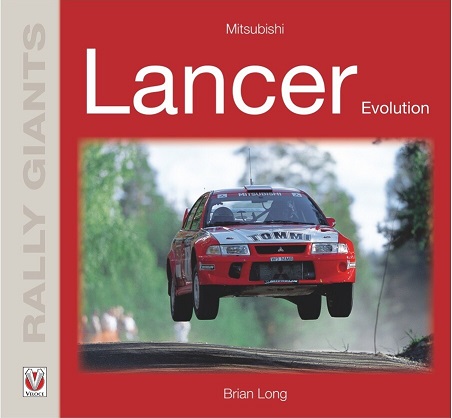
Mitsubishi Lancer Evolution (Rally Giants), by Brian Long.
ISBN: 978-1-787117-12-9, £19.99 (+ P&P).
Published by Veloce Publishing Ltd, Veloce House, Parkway Farm Business Park, Middle Farm Way, Poundbury, Dorchester DT1 3AR (UK).
Tel: +(0)1305 260068.
E-mail: info@veloce.co.uk. www.veloce.co.uk.
Click here to order or see a sample
Written by well known automotive author Brian Long, this book follows the story of the Lancer rally car (and Carisma GT - the same thing named differently), giving a quick overview of Mitsubishi's rally history up to the first appearance of the Lancer, and continues through each year until the official withdrawal of Mitsubishi from the WRC. It should be noted that the book almost exclusively concentrates on the WRC, with passing mentions of the Asia-Pacific Championship being the only addition. For the WRC you get record tables which give the finishing positions for each works crew, plus the car registrations as well (wonderful! Now if we could just have the finishing time as well.....). For other regional championships such as the European, British or American, nothing, not even in passing. But that would have made for a much bigger, and therefore more expensive book.
There are plenty of pictures, with one for most rounds of the championship competed in each year, as well as a quick overview of the mechanical changes to the car on a year by year basis, even down to gear ratios. As a brief overview of the car and drivers, it is great, but there are some important details missed, such as the vortex generators which were introduced on the cars, one of the first times that was done on a road car (see my review of Competition car aerodynamics (3rd edition), by Simon McBeath, which covers this). The photos in the book are also slightly washed out as they are printed on standard paper rather than thicker photo quality paper. But that doesn't detract from an interesting delve into the car's rally history, and which brought back to mind many things that I had forgotten. The cover shot sums it up perfectly as I remember it, with Tommi Makinen at full pelt.
Written 20th April 2023
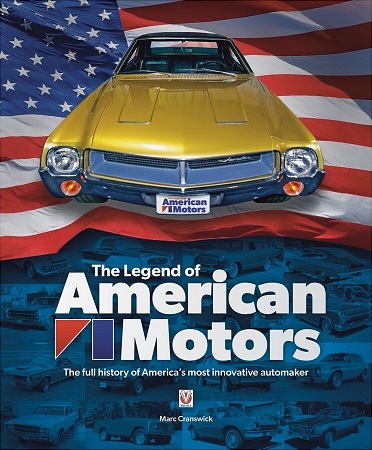
The Legend of American Motors - The full history of America's most innovative automaker, by Marc Cranswick.
ISBN: 978-1-787118-03-4, £60.00 (+ P&P).
Published by Veloce Publishing Ltd, Veloce House, Parkway Farm Business Park, Middle Farm Way, Poundbury, Dorchester DT1 3AR (UK).
Tel: +(0)1305 260068.
E-mail: info@veloce.co.uk. www.veloce.co.uk.
Click here to order or see a sample
It is a detailed study of all of the models made by AMC, and how they changed over time. New trim, new bonnet bulge, different gearbox, all are explained, with plenty of pictures to illustrate what was meant, populated with several slightly obscure American cultural references which I had to look up. It is also the book on which I made the most notes ever when reviewing. When I review a book, I typically make notes on things as I go along to make sure that I don't forget when it comes to writing the review. My list of notes was lengthy.
The text does make a few assumptions of knowledge, although it answers some of the questions I had eventually. For example, it uses the term MY from the off, but it is some way in before you learn that this means Motor Year. Cranswick also makes it abundantly clear what he thinks of the US pollution control laws by making repeated references to "smog nazis", the California Air Resources Board being a particular target for this epithet. It was one of a number of points which left me feeling that there was a slight lack of objectivity in the book.
Cranswick was so effusive about the popularity of the AMC Pacer in France that I had to go and do some more research, as it seemed to run counter to expectations. According to https://www.automobile-catalog.com/production/amc/pacer.html#gsc.tab=0, total production by AMC in 1975 was as follows:-
calendar year 1975 - AMC all versions, total production - 323704 units
calendar year 1975 - AMC all versions, total sales U.S. - 268526 units
Which means that there were 55,178 cars across all models sold throughout the rest of the world. Looking specifically at the AMC Pacer (source: https://www.classiccarpassion.com/en/magazine/featured-articles/2022/amc-pacer-ugliness-has-not-sold-well):
| Year | Number sold |
|---|---|
| 1975 | 145,528 |
| 1976 | 117,244 |
| 1977 | 58,264 |
| 1980 | 1,746 |
France produced 3 million vehicles a year around this time. Looking at actual sales in France during this period (source: https://raycee1234.blogspot.com/2015/10/car-sales-france-by-brand-local-1974-79.html):
| Brand | 1974 | 1975 | 1976 | 1977 | 1978 | 1979 |
|---|---|---|---|---|---|---|
| Renault | 548,915 | 488,925 | 602,827 | 640,384 | 665,271 | 691,544 |
| Peugeot | 278,538 | 282,886 | 331,434 | 336,425 | 351,285 | 358,698 |
| Citroën | 285,082 | 271,667 | 301,202 | 320,389 | 315,772 | 325,399 |
| Chrysler Europe | 135,765 | 133,106 | 191,111 | 180,031 | 198,754 | 156,513 |
| Others | 276,480 | 305,728 | 431,660 | 429,761 | 413,904 | 444,237 |
| Total | 1,524,780 | 1,482,312 | 1,858,234 | 1,906,990 | 1,944,986 | 1,976,391 |
Note that others also includes Ford, GM, the Japanese, as well as AMC. AMC sales figures for France were actually quite poor. While researching these figures I quite often came across the Paris based advertising poster comparing the rear of the car to a woman's derriere, and it was quite obvious that it was glamour and noise to try and sell the car, and predominantly just in Paris. Cranswick mentions the French loving to drive the car down the wide boulevards, and while that may be true of the Champs Elysées, can you imagine trying to get such a wide car through the streets of Montmartre? The narrative is claiming more success than there was, and for reasons which are not really true for France - they sell a lot of small cars there for a reason.
There were a couple of weird vignettes in the text. One, which mentioned a foreign student at a US college purchasing a 1976 Pacer in the late 1980s for $500 and loving the car, just begged the question why? And what relevance did it have to the narrative, what was particular about this one compared to the hundreds of other second-hand purchases? There is a section which compares a Pacer D/L 258 in the UK against a Ford Granada, but these were aimed at different markets, and in the US section it compared against the VW Rabbit (Golf) instead. The Ford model line at the time went Fiesta, Escort, Cortina and Granada, so it was two model lines out in the UK. Given the price differential (Pacer was 40% more), with similar performance and 25% worse fuel mileage, it is no wonder it didn't sell here. There are other examples of not quite getting the markets right - in the section on Jeep it ignores the Land Rover (later named Defender), only focussing on Range Rover. But Range Rover was a luxury product. The text focussed on the lack of standard automatic transmission, but this misreads the UK market preferences, where manual was very much preferred. The UK was the main market, so that was served first. Just like AMC did with its vehicles in the US.
Having said all of that, the hardback book is 348 high-quality pages full of facts, and if you want to know what was built by AMC, when, plus regional variations from assemblers in Australia, Argentina and Mexico, then this has it all. There are also sections on where the cars raced, covering drag racing, IMSA and SCCA series. If you ignore the opinion, it's a comprehensive account of the cars, and covers a manufacturer not often covered elsewhere. But come the end I did feel one thing was missing. The tagline of the book says that AMC was America's most innovative automaker, but there was no conclusion at the end to back this up, drawing the threads from the story together to back up the claim. Was AMC innovative by American standards? Probably - it went after markets in different ways. The most innovative? Perhaps compared to GM and Ford at the time, but I have a feeling that some of manufacturers from earlier in the century also have a strong claim. Discuss.....
Maybe Fix It Again Tony (a favourite Cranswick aphorism in the book) has had the last laugh. Chrysler may have bought AMC, but (and after Daimler-Benz tried and failed to make a success of it) FIAT bought Chrysler and formed Stellantis. The looked down upon small European car producer is now at the heart of motor city, and it is Chrysler which is being fixed yet again.
Written 14th April 2023
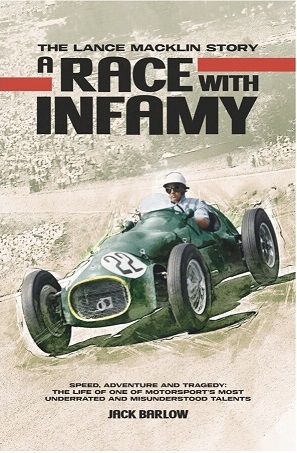
A Race with Infamy - The Lance Macklin Story, by Jack Barlow.
ISBN: 978-1-787117-87-7, £20.00 (+ P&P).
Published by Veloce Publishing Ltd, Veloce House, Parkway Farm Business Park, Middle Farm Way, Poundbury, Dorchester DT1 3AR (UK).
Tel: +(0)1305 260068.
E-mail: info@veloce.co.uk. www.veloce.co.uk.
Click here to order or see a sample
Macklin had the ability, but was another of those who didn't have that ultimate killer instinct which marks out so many champions, and which drives so many to be successful in whatever they attempt, be it in sport or business. He wanted to race, but it wasn't the be all and end all, there was life to be led, and then there was the shadow of his successful father, Brooklands racer and businessman, who didn't want his son to race. Born into a wealthy family, Macklin had to earn his own way in the racing world.
This and more is covered in the biography written by Jack Barlow in 212 A5ish pages (which includes 22 picture pages spread in three sections through the book). It is an entertaining read, with plenty of vignettes on the escapades Mackiin got involved with as he criss-crossed the continent racing for HWM. I particularly loved one involving Jon Pertwee of Dr Who fame hamming it up escaping a boat in Paris, delaying the pair sufficiently to be collared by the local constabulary. It of course goes through the events of 1955, but it doesn't dwell on it - it is one chapter amongst many, albeit a thread which reappears from time to time to put into context later reactions and events. Later chapters include comments from interviews conducted for the book, but as these are necessarily missing from the early years, assertions about what Macklin was thinking or dreaming, while probably correct, felt a bit more fictional, something which was particularly true for the discussion on what happened to Rosa Koth - she vanished into obscurity according to the text, which then goes on to talk about her memories, drinking and thinking. Given what was said, how could you know?
The story continues onwards after the tragic events and Macklin's withdrawal from racing, covering his marriages, jobs and escapades, fleshing out the story of someone who seemed to realise later in life possibly what they had lost and what was the cost of a life lived as his had been. It is a book covering one of racing's lesser known characters, and for that it is well worth a read.
Written 4th August 2022
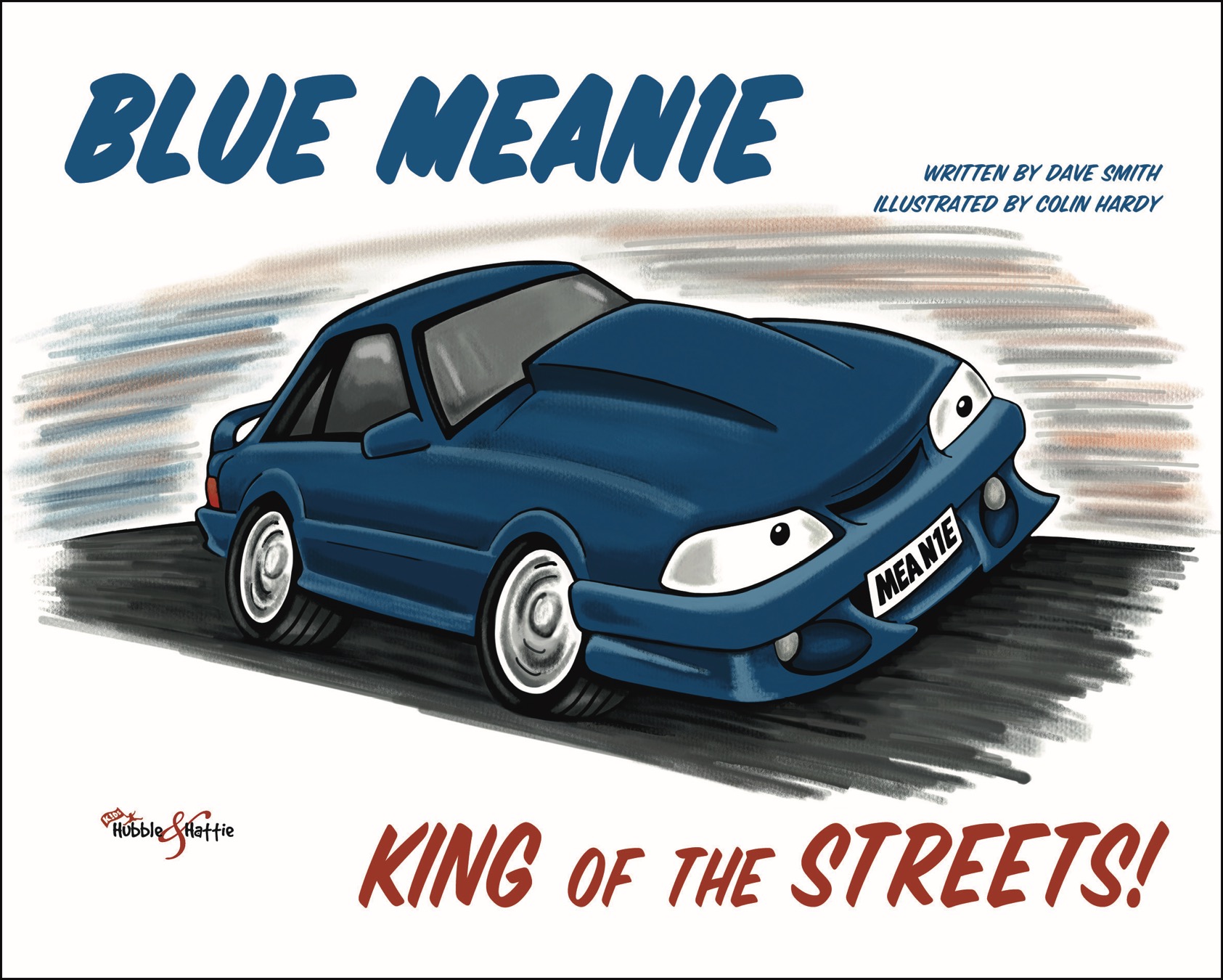
Blue Mean1e - King of the Streets, by Dave Smith and Colin Hardy.
ISBN: 978-1-787117-48-8, £8.99 (+ P&P).
Published by Hubble and Hattie, Veloce House, Parkway Farm Business Park, Middle Farm Way, Poundbury, Dorchester DT1 3AR (UK).
Tel: +(0)1305 260068.
E-mail: info@veloce.co.uk. www.hubbleandhattie.com.
Click here to order or see a sample
As an adult reading it to a child (the target age being four and over), I struggled slightly at times with the syllables and trying to get the rhythm to match, but the story was clear, the underlying point that all these stories purvey was well made, and the pictures were bright and well done - the choice of the Lamborghini Countach over a Huracan perhaps pointing to the age of the artist, little things which add to the story for an adult but do not matter to the child being read to. It was a great little book which just happens to use cars and drag racing as a setting rather than animals.
A nice touch was the glossary at the back to explain a couple of the drag racing terms used in the story. No doubt a child would ask about a "Christmas Tree" at a drag racing track, and rather than trying to work out how to explain it, you can just go to the back and read it out.
Wanting a second opinion, I gave the book to a younger reader to read. "Loved the pictures, and loved the story" was the response. "Much better than I expected". So job done!
Written 22nd May 2022

The Essential Buyer's Guide: Ford Mustang 3rd Generation, 1979-1993, including Mercury Capri 1979-1986, by Dave Smith.
ISBN: 978-1-787117-30-3, £14.99 (+ P&P).
Published by Veloce Publishing Ltd, Veloce House, Parkway Farm Business Park, Middle Farm Way, Poundbury, Dorchester DT1 3AR (UK).
Tel: +(0)1305 260068.
E-mail: info@veloce.co.uk. www.veloce.co.uk.
Click here to order or see a sample
It didn't look so promising by the time I got to page 10, cost considerations. It gives you a list of typical parts and a price. As it is aimed at multiple markets, it attempts to cover all bases by using a base currency and giving the exchange rates at the time of writing. Except that this little explanation is right at the end of the contents at the bottom of the page, and I completely missed this when reading through, and was somewhat flummoxed by what I read (didn't help that I skipped the contents and went straight to the main text). There was space at the bottom of page 10 for the explanation to go there, and it would have made things much clearer.
But get past that and you get to the meat of the book, where it goes through all of the things to look at when buying one of the cars. It is your knowledgeable friend who has already been there and done that, telling you what to expect and where to look, and best of all doing it with pictures so that you are forearmed and forewarned, and can clearly understand what the text is trying to convey. It has a scoring system for each thing to look at so that you can tot up the results and see how good the prospective purchase is.
There is some additional information, such as how many of each model were produced, what models there were, and where to go to find suppliers and owners clubs. By the time I got to the end of the book there wasn't anything that sprang to mind as being obviously missed. Unless you are already immersed in the world of this car, it would seem to be a worthwhile investment to help avoid hidden nasties, and to go back to the beginning of this review, the size of the book is actually a plus - it means that you can easily slip it into a decent coat pocket for when you go and take your first look.
Written 20th May 2022
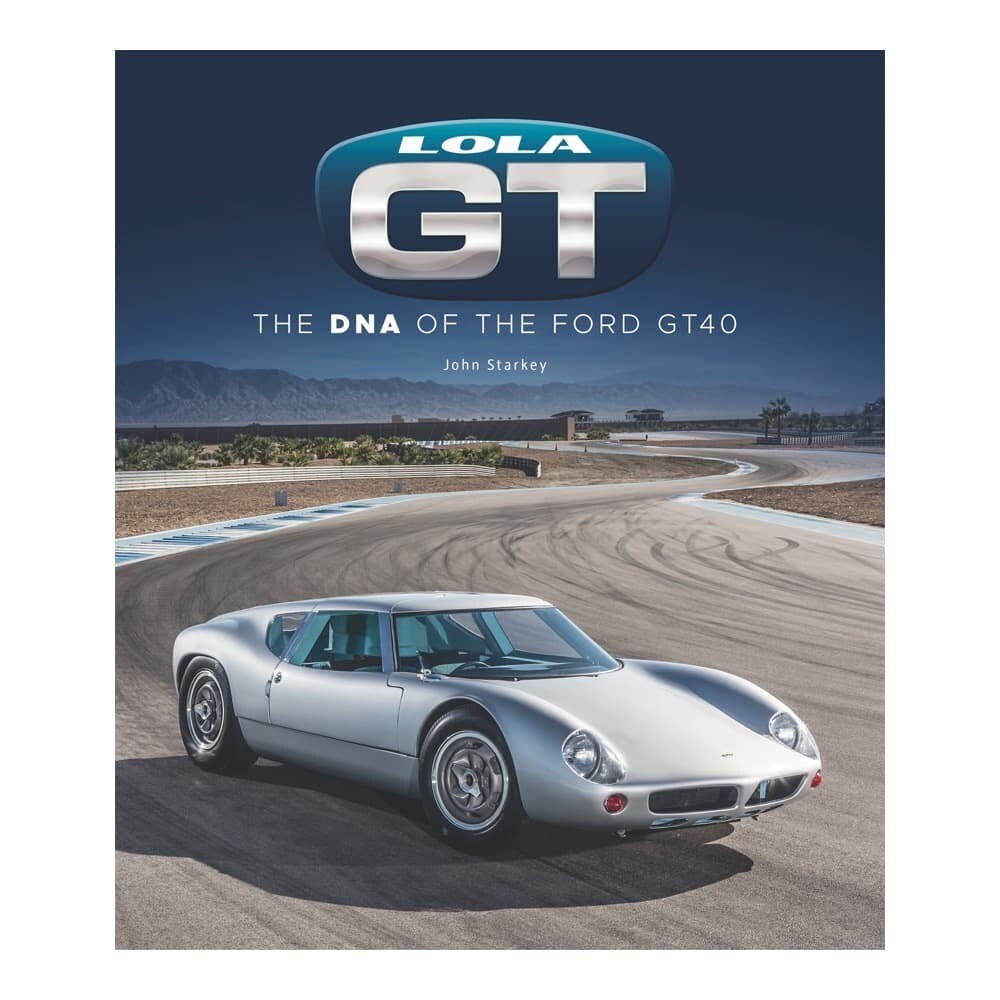
Lola GT - The DNA of the Ford GT40, by John Starkey.
ISBN: 978-1-787117-83-9, £35 (+ P&P).
Published by Veloce Publishing Ltd, Veloce House, Parkway Farm Business Park, Middle Farm Way, Poundbury, Dorchester DT1 3AR (UK).
Tel: +(0)1305 260068.
E-mail: info@veloce.co.uk. www.veloce.co.uk.
Click here to order or see a sample
The storyline is predominantly about the process of how the Lola GT was developed into the Ford GT, backed up by a number of reproductions of internal Ford documents written by Lee Iococca and Roy Lunn. The politics of the situation between Lola and Ford, and getting the production underway are discussed. It is interesting, but I got the creeping feeling that the book wasn't really about the Lola GT, it was another Ford GT40 book. It discusses the Lola GT, but it is really setting the scene for something else. There is a chapter which goes into a brief history of each of the chassis (and there were only three), but due to their limited competition history that doesn't go far. The original prototype underwent a recent restoration, and although there is a chapter of photos from various points of that process, I feel that a trick was perhaps missed here, as the author could have explored with the restorers what went into the car, how it compared, what stood the test of time. The pictures are nice, but they don't necessarily highlight in the captions what made it special or different, what you should be looking for in the picture. There is a lot of comparison to the Ford GT40 which was developed from it - again, nice, but that doesn't tell you more about the Lola.
So I checked the book Ford versus Ferrari - The battle for supremacy at Le Mans 1966 by the same author, and specifically chapter 2, in which in 20 pages it covers the Lola Mk 6. It also features the same three page Ford internal communication reproduction, the same photo of the Mecom car being towed by a Fiat 500 at Sebring, and at least two other identical photos. So what the book really is is an expansion for that chapter, with additional material covering what became of these cars specifically, and more shots of the internals from the renovation.
As a standalone book on the topic, it is the usual well written piece by the author which is easy to follow, with a great range of photo's, and a lot of them. It necessarily covers some of the same material as some of his other books, it just would have been nice if some of the material wasn't exactly the same.
Errata
PG 78 - incorrect photo caption. It says "A chart produce dby Ford showing the lineage of the GT40. Somehow, the Mach 1 Mustang appears to be the forebear." That should be the Mustang 1, as stated in the text.
Written 4th April 2022
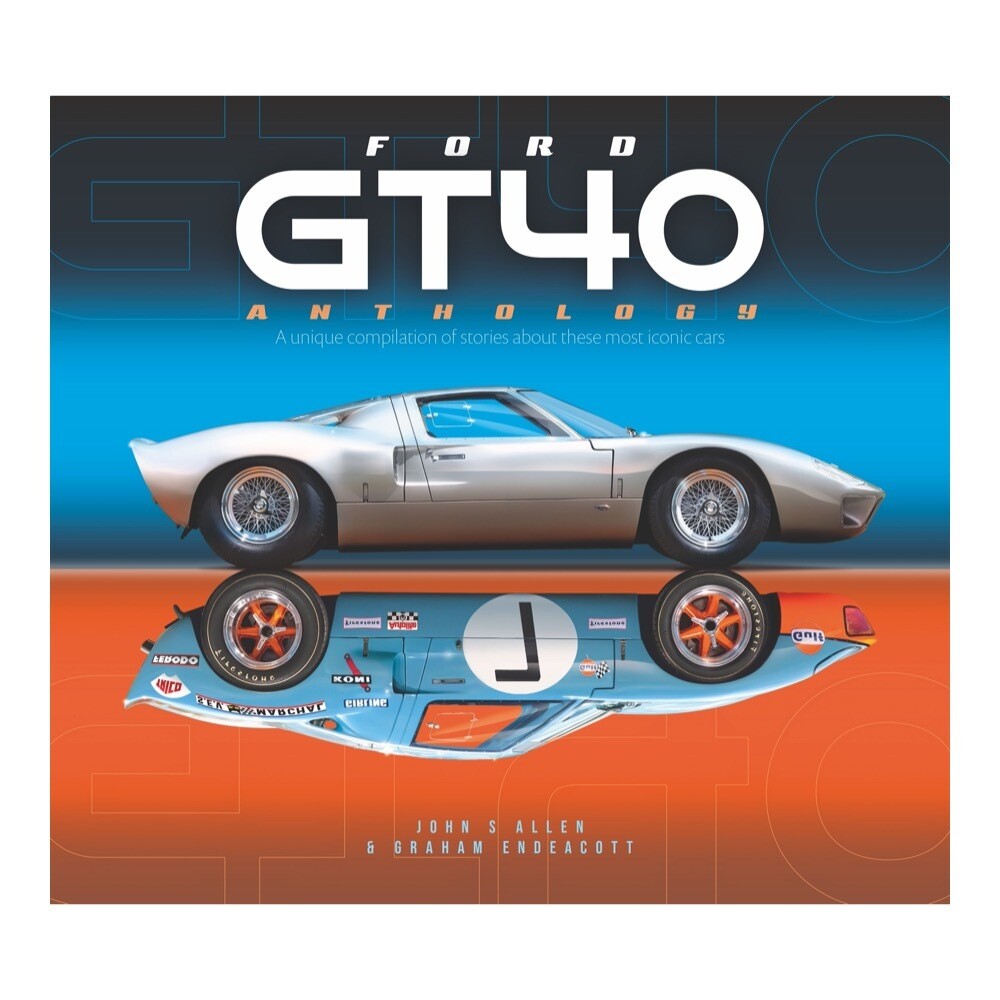
Ford GT40 Anthology, by John Stuart Allen and Graham Endeacott.
ISBN: 978-1-787115-78-7, £60 (+ P&P).
Published by Veloce Publishing Ltd, Veloce House, Parkway Farm Business Park, Middle Farm Way, Poundbury, Dorchester DT1 3AR (UK).
Tel: +(0)1305 260068.
E-mail: info@veloce.co.uk. www.veloce.co.uk.
Click here to order or see a sample
And they have largely succeeded, and hence there is no story arc, no single thread linking the beginning to the end apart from the fact that it is all related to the GT40 in some way. To that end, the authors have also put in particular efforts at sourcing never before published pictures, and there are lots of them, with some chapters largely consisting of captioned pictures rather than text. Of particular interest to me were the chapters showing the original prototype build, and cars under construction at JWAE/FAV - the sequences of detailed pictures takes you through the build process, showing the small details which distinguished the different chassis from each other, and highlighting the tremendous amount of work which went in to the program.
Also covered in detail is the story of Ken Miles, as mentioned in passing in Ford versus Ferrari - The battle for supremacy at Le Mans 1966, by John Starkey (see earlier review), with much more surrounding evidence, going as far as pictures of birth and death certificates. It's clear what the authors position on this was, but you have to wonder why someone would do this. At the time of going to press, the late Ken Miles would have been 103, so the reasons have probably passed along with him.
One chapter which did make me ponder was the one on the restoration of Mk III 1101, which was “restored” from the configuration it was eventually in back to the state before it underwent the first rebuild to the 1101 road spec. This follows a modern trend of buying a car with history, and then restoring it back to an earlier configuration. I think that I have a problem with this, as you are erasing history to recreate history, and all race cars evolve over time as improvements are made – are we saying that any subsequent changes are invalid? And the spec chosen to go to is one moment in time – this particular GT40 was a prototype, so was changing all the time, so which changes will you take, which will you not? And the other problem is that if you do restore the car, it will still never be the same as the original one. Even if you recreate the exact components, you are using newer materials, newer manufacturing techniques, and some things will not be the same because you can no longer do it. And it’s like the mythical boat, where if you change one plank at a time until you have changed the whole boat, is it still the same boat? The car has a history, celebrate it, because all that it went through is still there somewhere, and by restoring it to a previous specification you are throwing some away.
But the book.... It's printed on heavy paper with good quality photos, and as it is 320 pages long it weighs a lot. It won't fit through the letter box, and when mine was delivered, it was in the middle of storm Eunice, when winds were gusting at over 70mph. I have a sneaking suspicion that the book would have helped keep the delivery van on the road..... It kept my interest throughout, and does what it set out to do, not being just another GT40 book.
Errata
PG 68 - says "Jim Clarke" twice.
Written 18th March 2022
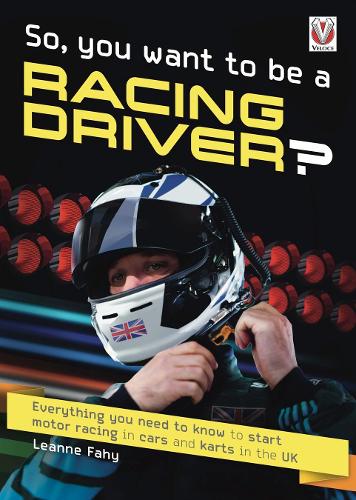
So, you want to be a racing driver?, by Leanne Fahy.
ISBN: 978-1-787117-43-3, £14.99 (+ P&P).
Published by Veloce Publishing Ltd, Veloce House, Parkway Farm Business Park, Middle Farm Way, Poundbury, Dorchester DT1 3AR (UK).
Tel: +(0)1305 260068.
E-mail: info@veloce.co.uk. www.veloce.co.uk.
Click here to order or see a sample
What it is instead is a guide through what you need to do before actually racing in the UK. It takes you step by step through what you will need to do and the likely costs of getting your racing licence, what kit you will need, what championships you could consider entering, the clubs in this country and what they run (although I don't know why it was missing the Castle Combe Racing Club, or missing the Castle Combe FF1600 championship from the list of single-venue FF1600 championships - a small oversight perhaps), and what you might consider to prepare yourself for racing, such as race instructors and simulation centres. It gives lists of who to contact, and kit that you may need to get - and where to purchase it. The book is a very clearly written best mate to help you past the unknown hurdles. And having read the book I would be that little bit more tempted to give it a go, particularly on learning about the 750 MC's offer which involves a Honda race car thrown in.
There are few photo's, and those that are there are in black and white, but to be honest this doesn't detract, as the text is perfectly clear enough. It treats karts and cars equally well, and is uptodate enough to explain how Covid has impacted the process today. Given the outlay to get going, this book is a small investment to make sure you do it right. And if there is one thing I take away from the book, it is that you shouldn't forget to take your kettle.....
Errata
PG 125 - Says that "provides 25nm of torque". nm as a unit is nanometres - should be Nm for Newton-metres.
Written 15th December 2021
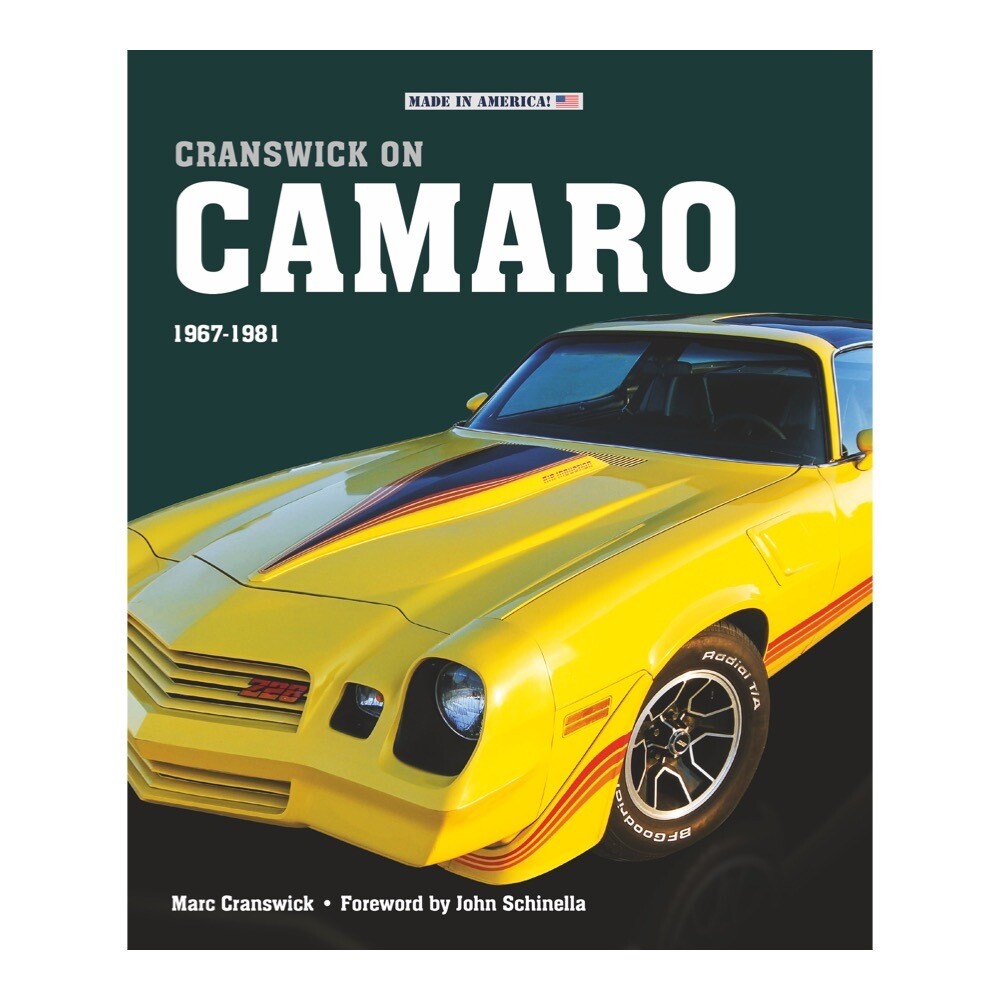
Cranswick on Camaro 1967-81, by Marc Cranswick.
ISBN: 978-1-787116-68-9, £25.00 (+ P&P).
Published by Veloce Publishing Ltd, Veloce House, Parkway Farm Business Park, Middle Farm Way, Poundbury, Dorchester DT1 3AR (UK).
Tel: +(0)1305 260068.
E-mail: info@veloce.co.uk. www.veloce.co.uk.
Click here to order or see a sample
Apart from being the author (and I note of more than one book), by the end of the last page (and the covers, inside and out - I read everything) I’m still non the wiser as to who Cranswick is, and I can pronounce Dauphine (you’ll understand when you’ve read the book). I felt that this was a book which had not crossed over the pond particularly well - it was a little hard going in places, as the book assumes a level of knowledge, and used some terms and abbreviations without explanation. There was too much US slang and abbreviations used - in some places I had no idea what is really being said. It could do with a glossary - what is an lsd for instance? I eventually worked out mid-book that this was limited slip differential, but given that the car was conceived in the 1960s, another definition initially sprang to mind. It also didn’t really need the scantily clad women with car shots, as they were modern photos rather than contemporary pieces placing the car in the culture of the time. Pretty though the lasses are, things have moved on, and the car can sell itself.
What it is is a book for those into and familiar with the American car scene, and hence a little inaccessible in places for the more casual or less informed reader. It is highly detailed in what it does cover, for example engine options and car configurations, and great for sales figures, but only in the US. There was mention of 1st generation assembly outside of the US, but this was very brief - was it through the whole of the 1st generation lifestyle, when did it stop? Why didn't it continue to other models? There were a few unanswered questions here. It could do with a little more editing, as a few spelling mistakes and grammatical/readability issues crept through.
Cranswick does seem very determined to blame US government legislation for what happened to the US car industry, and although pollution laws and passive safety restraints had an impact, suddenly jumping forwards 40 years and claiming that relocating production to China was an indirect outcome of this, and that due to the resulting number of GM factories there the global financial crisis government bailout to protect US jobs was of questionable value, is perhaps a stretch too far. It is ignoring political realities – if GM wants to sell into the largest car market in the world, it has to build cars there itself, and use suppliers or partners from there – China doesn’t let manufacturers in otherwise, and it affects all car makers, not just GM. Production has not relocated there, unlike the move to factories in Mexico – this is new production for a new market, and if they hadn’t been built, then the cars exported to China would probably have come from plants in South America and Europe which produced the small cars needed. What the bail-out probably did was stall the progress towards automation, and for car assembly this is what has really changed the number of jobs available. Even if all of GMs car production was moved to the US, you simply wouldn’t get the commensurate numbers of jobs anymore. The world has moved on, just like the Camaro, and just like technology, which is why you can now get big engine cars which meet the emission legislation, as demonstrated by the latest Ford Mustang.
And finally, to me at least it seemed to have an abrupt end. The 1981 sales figures and new electronics were discussed, and it just stops, with no real conclusion or wind down over what happened next. So what to take away? It is a well priced book, with a lot of detail on what was original factory option and what certain aftermarket upgraders did, so of great use if you are buying one and want to work out what was original. A book to sit and read cover to cover as a story it is not. If nothing else it is an education in US car idioms! And with lots of photos which show the detail changes in the car over time, and with reproduced sales literature to show how the targetting of the car changed through the period. If only you could publish the sound that the V8 engines made as well.....
Errata
PG 166 - Joey Chitwood should be Joie.
Written 3rd August 2021
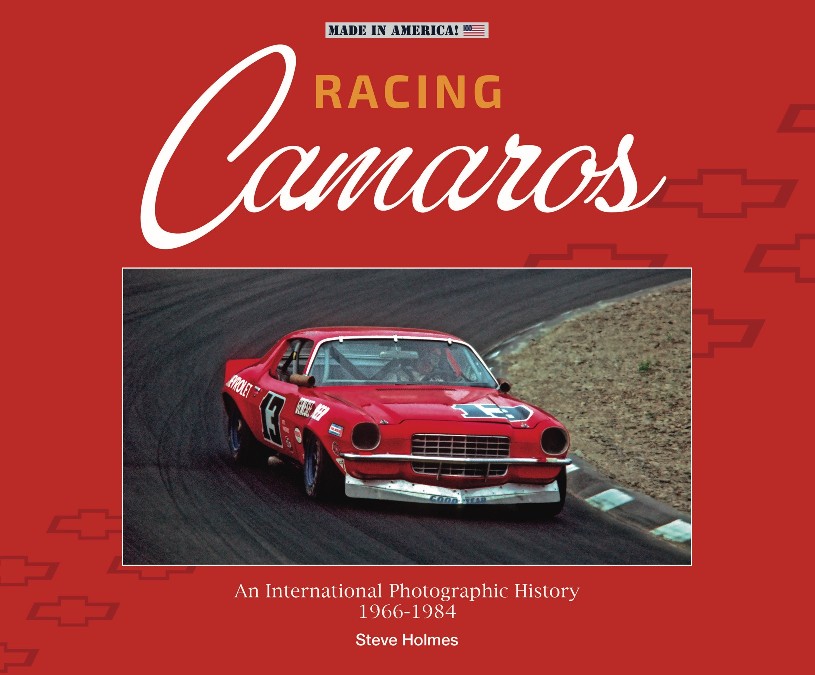
Racing Camaros - An International Photographic History 1966-1984, by Steve Holmes.
ISBN: 978-1-787115-12-5, £25.00 (+ P&P).
Published by Veloce Publishing Ltd, Veloce House, Parkway Farm Business Park, Middle Farm Way, Poundbury, Dorchester DT1 3AR (UK).
Tel: +(0)1305 260068.
E-mail: info@veloce.co.uk. www.veloce.co.uk.
Click here to order or see a sample
First, the abridged version: It's the same as the Ford Mustang book by the same author reviewed before, but on Chevrolet Camaros, with the odd Pontiac Firebird thrown in. Good book.
Secondly, a longer version.....
This is another well prepared book put together by someone who obviously loves the topic, but I couldn't help but feel that the Ford Mustang book was the true labour of love, and first interest, and that the Camaro was the next step along. The book is still well done, but the Ford book contains a little more explanation, and a little more detail in places (early on in the book there were some mentions of people before explaining who they were later, for example, Vince Piggins, and it doesn’t explain some things such as class O2 and U2 in Trans-Am which were explained in the Mustang book), and as such the two books complement each other well. It just means that this particular book isn't quite as good as a standalone book compared to the Mustang one - but they are still both worth having. This is despite my pet favourite being covered to some extent in the Mustang book but not here - there were no chassis numbers!
The book goes through year by year, with a text description of the year, covering various countries, followed by pictures which document the cars, with lengthy captions for each one. The homologation processes involved, and developments hence provided, were interesting to read about, with reproductions of various documents provided to show that the cars really did comply with the FIA requirements, even if some of the evidence was dubious. There are also numerous tales which shine a light on how teams exploited and trampled all over the grey areas of the rule book - acid dipping, sand blasting, 20 foot fuel towers and dry-ice cooled fuel feeders are all included. And surprisingly this wasn't all done by Smokey Yunick....
The book stops at 1984, which is a natural cut-off based on its usage in the main US racing series. But the cars did continue racing after this - I remember David Krayem with a highly modified example in the Castle Combe Special GT Championship in the 1990s, so the book could have perhaps covered a few more years. But as an international level race car its career was over - never since this period that this book has covered have US built and designed race cars achieved such world wide popularity, or been raced so widely. But one question did remain unanswered at the end......
Will there be a “Racing Javelins” and “Racing Cudas” to complete the pony car set?
Written 26th April 2021
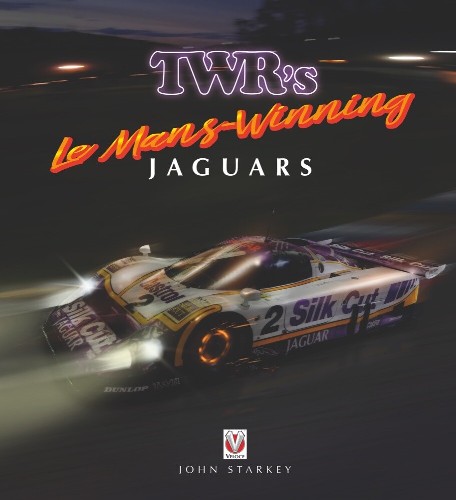
TWR's Le Mans-Winning Jaguars, by John Starkey.
ISBN: 978-1-787115-68-2, £19.99 (+ P&P).
Published by Veloce Publishing Ltd, Veloce House, Parkway Farm Business Park, Middle Farm Way, Poundbury, Dorchester DT1 3AR (UK).
Tel: +(0)1305 260068.
E-mail: info@veloce.co.uk. www.veloce.co.uk.
Click here to order or see a sample
There are pictures - lots of pictures - probably more than half the book. And I mention this fact first because I think it puts what the book is trying to be in a little more context. I would describe it as a lightweight book on the subject - it is a nice summary of the results and achievements, and what happened in the races, but it is not the detailed book on the subject which this author has done for marques such as Lola. It is lacking some of the details he has used in other titles, such as drawings of the internals, or more detailed descriptions of their construction and development. But it is easily accessible and reads easily, and is a great introduction to these wonderful cars. There are quotes from the drivers describing how they found it used at the right points, and you get some idea about team proprietor Tom Walkinshaw. It would have been nice to have seen similar quotes from the engine builders and designers involved to gain more insight into the cars themselves.
At the end of each chapter is a chassis list for the cars produced that year, which lists the results for each car and what they did next, but I’m not 100% sure about the completeness of this, because I remember two Jaguar XJR’s being raced in the Castle Combe Special GT championship in the mid-1990s. The first was raced by Brian Chatfield, who was always having problems with the noise limit. In one particularly memorable meeting, he filled the exhaust pipes with metal wool and pootled around in practice, getting a position on the third row, complying with the noise limit. Come the race, at the start he put his foot flat to the floor, wodges of material came flying out the exhaust, and he was past the next row before it had barely moved – the car was normally aspirated, and strangely noisier in race trim. Chatfield is mentioned in this section, but for a car which was completed by Dave Appleby – I think this was the second yellow XJR which appeared. Again, in one memorable wet race, Appleby was in second, and was struggling to overtake the car in front. Having gone around Quarry corner, he decided to push the boost button on the steering wheel (this car was turbocharged) – he shot past the car in front and won the race, but he was distinctly shaking when he got out the car after winning, as he had never pressed the button before. It looks like this latter car is 491 in the book, but the former one isn’t identified.
But I digress - I enjoyed reading the book, and I got through it quickly as a result. With the copious pictures you can easily track the development of the cars, and it is great that despite the title suggesting a focus on just Le Mans, it covers the sportscar world championship and the US IMSA campaigns. I just have the feeling that there are a few more people to talk to and a few more stories out there.
Written 26th November 2020
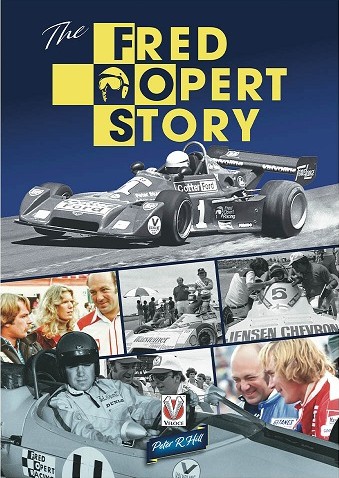
The Fred Opert Story, by Peyer R.Hill.
ISBN: 978-1-787115-65-1, £16.99 (+ P&P).
Published by Veloce Publishing Ltd, Veloce House, Parkway Farm Business Park, Middle Farm Way, Poundbury, Dorchester DT1 3AR (UK).
Tel: +(0)1305 260068.
E-mail: info@veloce.co.uk. www.veloce.co.uk.
Click here to order or see a sample
What was surprising to learn was just how many people who run US motorsport today graduated through the school of Opert, whether it be in Indycar or the SCCA. This might be a smallish book compared to some, at only 150 printed pages plus photo sections, but there is a lot to pack in. The book has a definite starting point - the singular event which pushed Opert down the motorsport road - and as a consequence doesn't cover so much his formative years. It is more of a biography of his time in racing.
The author has spoken to many people involved in the early years, but to me at least the quotes often seemed a little lightweight - there wasn't quite so much behind the scenes description, and there wasn't so much description of Opert the man - in fact some of the descriptions didn't paint him in so good a light, which is to commend the author for being objective. It is only in the final chapter that we really get some personal insights. It also seemed a little odd that despite the Rosberg's, both Keke and Nico, writing foreword pieces, there wasn't as much comment or insight from them as you might expect, despite the highlighted friendship. I guess it depends whether you are after a biography of Fred Opert the person, or his racing team - other books strike a different balance.
It is an enjoyable read which shed light on a period and area of racing which is not so well known here in Europe, it's just that for me it left several "why's" unanswered, but it could well be that since Opert has passed away, no-one knows any longer. Opert was highly influential on the US racing scene, and helped to develop ways of working and business which have since been widely copied - this book does a good job of making sure that this is remembered.
Errata
PG 107 - Estoril is west of Lisbon, not east.
Written 15th October 2020
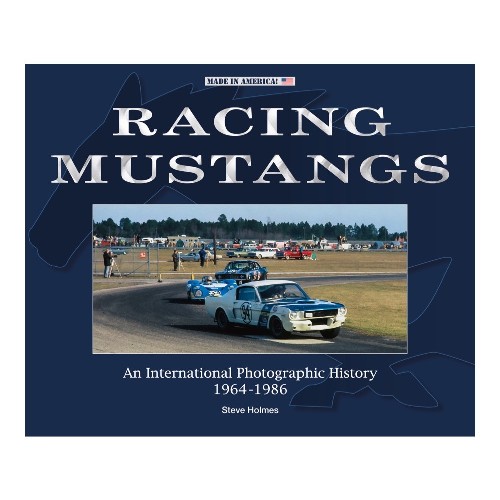
Racing Mustangs - An International Photographic History 1964-1986, by Steve Holmes.
ISBN: 978-1-787115-11-8, £25.00 (+ P&P).
Published by Veloce Publishing Ltd, Veloce House, Parkway Farm Business Park, Middle Farm Way, Poundbury, Dorchester DT1 3AR (UK).
Tel: +(0)1305 260068.
E-mail: info@veloce.co.uk. www.veloce.co.uk.
Click here to order or see a sample
What, I should write some more?
The book is hardback, and although it bills itself as a photographic record, there are captions for each photo, and a number of pages of introduction to each new year and section which describe the changes and the events. Although obviously US centric, it also covers the cars competition outings in the UK, Australia and New Zealand, as well as the early 1980s entries from Zakspeed in Germany. With 170 pages of pictures and information, there is much to learn and find - for instance, I hadn't heard of the War Bonnet track in Oklahoma, used from 1966-68, and which the fledgling Trans-Am series raced on. The pictures from there were great - it makes the likes of Castle Combe in the UK look a lot less small and a lot more uptodate when compared.
The book does what is says it will do - it was never intended to be an in depth description of how the cars were put together, or the teams that run them, and it's not - if that is what you are after, you need another book. The only thing missing for me is a summary table at the back of the book covering the cars’ results. But then it is a photographic record.....
Errata
PG 144 - Typo: "German Open Commodore", should read Opel instead of open.
Written 7th June 2020
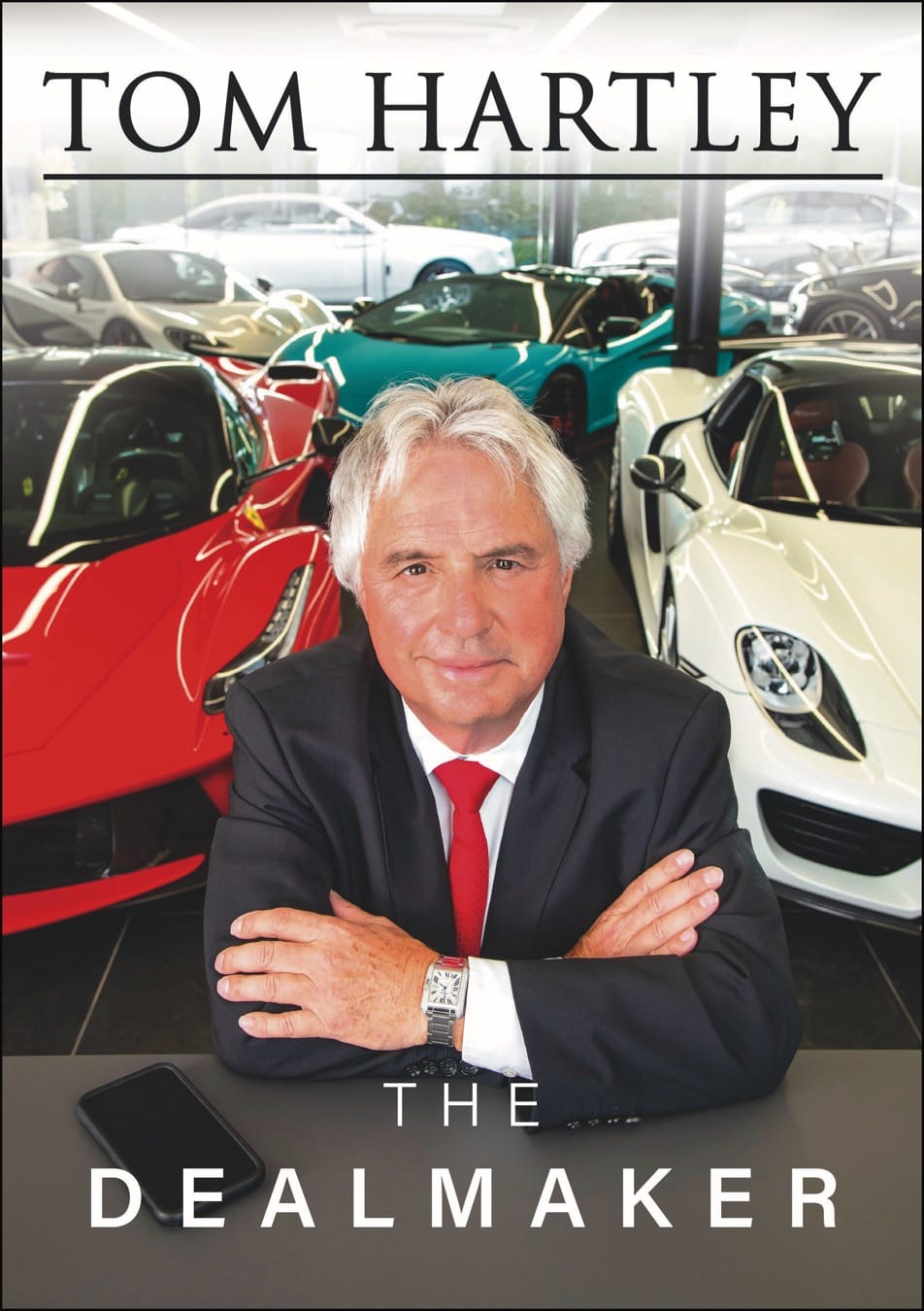
Tom Hartley - The Dealmaker, by Tom Hartley.
ISBN: 978-1-787115-67-5, £19.99 (+ P&P).
Published by Veloce Publishing Ltd, Veloce House, Parkway Farm Business Park, Middle Farm Way, Poundbury, Dorchester DT1 3AR (UK).
Tel: +(0)1305 260068.
E-mail: info@veloce.co.uk. www.veloce.co.uk.
Click here to order or see a sample
I must admit that I changed my mind while reading this book. I imagined at first that the book could be a vanity project, due to its nicheness, but by the end of it I had decided that this wasn't the case, although I did get the occasional feeling that the book itself was a subtle piece of advertising for the business, laying out what they could do for you as a customer, reinforced by the many references to never wasting an opportunity. I think that my view changed through reading because the book also changed. At the beginning, the book seemed to be a list of facts, without so much in the way of why and discussion of thoughts - there wasn't so much there to understand the person. And there was the fact that a third of the way in in a picture section we learn that Hartley had a brother, with no mention in the text up to that point. It felt odd, a strange omission, and made you think what else had been missed. But these questions and omissions were covered in later sections. I also found myself slightly irritated by his use of the dismissive term fancy education in the early pages. You may not need one to be successful - Richard Branson is another who springs to mind - but without those who have one he wouldn’t have the products that he is making his millions from.
As you move through the book to the later pages, more and more of the personal thought is revealed, together with contributions written by family members. Gradually the view of the person is built up, and you get more of a feeling for the subject.
As an autobiography it does what it should do, shedding light on the subject. There are positives to take from the story, and for this reviewer there were some negatives to take as well. But that is as it should be - people are people, and to be driven and successful there are necessarily some hard edges, and there will be opinions to disagree with. But the fact that you can disagree means that it isn’t just full of bland inoffensiveness and saying things to please. There will be bits you like, others which may jar. But you will at least read it to the end, and will gain some understanding of what goes on in a world often hidden away.
Written 26th May 2020
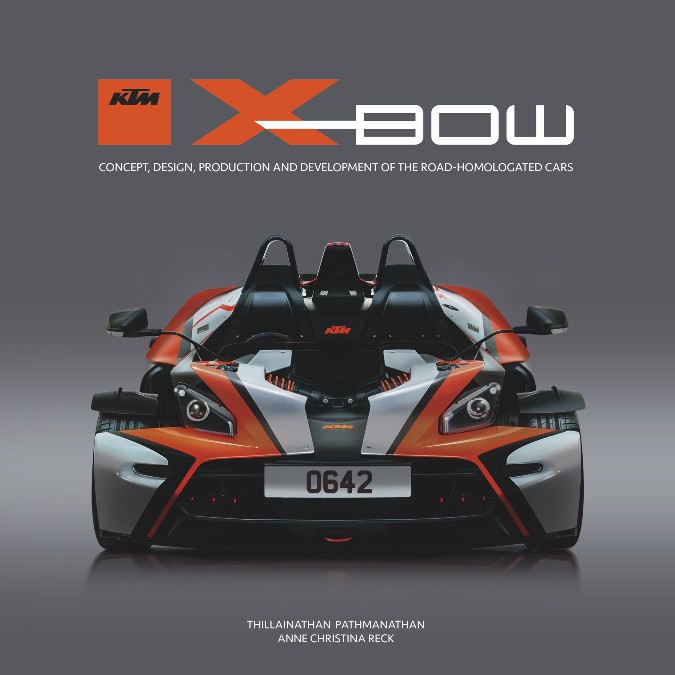
KTM X-BOW: Concept, Design, Production and Development of the road-homologated cars, by Thillainathan Pathmanathan and Anne Christina Reck.
ISBN: 978-1-787114-33-3, £50.00 (+ P&P).
Published by Veloce Publishing Ltd, Veloce House, Parkway Farm Business Park, Middle Farm Way, Poundbury, Dorchester DT1 3AR (UK).
Tel: +(0)1305 260068.
E-mail: info@veloce.co.uk. www.veloce.co.uk.
Click here to order or see a sample
I'm not sure that that question was ever actually answered - the X-BOW was meant to be simple but using the most technologically advanced materials possible, so then why not the same for the bikes? Probably something for another book. So what is this one like?
The foreword by Sebastien Stassin was one of the most poetic and evocative that I’ve read in an automotive book, and certainly sheds some light on the motivation behind it, and in the later pages there is so much technical information and diagrams that it would push a Haynes owners manual of the car close for detail at times. There are many full page spread photo's of the car, its constituent parts together with parts of the assembly process. These parts I particularly liked. However, I found some of the other parts of the book perhaps a touch too hagiographic. The text is perhaps too uncritical, with everything seen as wonderful - the term objet d'Art was used more than once. Things are always just better, but how does it compare to competitors such as Radical, or the Ariel Atom, which are competing in the same market? There is a section which mentions some cars going after the same niche, but there is no real comparison of what makes the X-BOW different or stand-out from them - it is simply a list of the cars with their pictures and some facts.
Kudos to the authors for mentioning the barely known 1867 Manchester steam carriage “race”, but a section on how sports cars eventually developed from this didn’t really seem relevant to the car - interesting, but not telling me about the subject. Again, the double page spread on the Dallara Stradale was interesting, but was it really relevant to the KTM X-BOW story? Sure it shares some DNA as Dallara did design work on both, but it isn't a derivative in the way that the X-BOW GT is a derivative of the first version. Ditto an explanation of the 2008 financial crisis causation. There was a little too much tangential explanation, and hence the book felt a little padded out. It was also a little repetitive at times, revisiting facts which had already been stated. Not least the KTM company motto "Ready to Race", which was used ten times in the book, and that does not include the play on word variants also used.
I also felt that the politically charged statements on page 81 on using population control to “truly“ control climate change were really not needed in a book such as this, and it is not an “indisputable fact” that lowering population numbers would solve the issue, not if the remaining lower numbers all increased their consumption, and couldn't a population agree to control emissions? While I agree on climate change, there are other things that can be done, and driving a high performance sports car which requires expensive carbon fibre produced in high temperature autoclaves and thus carbon emissions, and having at least four different supercars in the garage, isn't one of them, not without a lot of offsetting.
There are some interesting things to learn about KTM and the X-BOW, over all of the various derivatives, which you won’t find elsewhere, and it was certainly interesting learning about the manufacturing processes. However, for the size of book it is a little expensive at £50, but if you can afford an X-BOW in the first place, then it would be a great coffee book object which guests could browse to learn why on earth you spent your money on something which in the UK at least you will get very cold and wet very frequently in..... Although the author does suggest mitigation factors you can take to get around some of that. Just not the rain, unless you get the GT.
Errata/Points
PG 18 - Typo in picture caption bottom left - Gerard Kiska should be Gerald.
PG 56 - Maggstrabe should read Magstrasse - mis-transcribed the ß (sharp-S) from German to English.
PG 81 - “....optimise the airflow at the boundary layers, where the airflow over the body separates at the end of the car.” The boundary layer is the layer of air which “sticks” to the car surface or is affected by it. At the end of the car the disturbed air forms the wake. This does form drag as the text says, but is influenced by the body shape. See the books on car aerodynamics reviewed previously.
PG 81 - Vortex generators are also found on the rear roof edge of later Mitsubishi Lancer Evo’s, not just aircraft.
PG 95 - Doesn’t mention that the pedal box had to be adjustable because the seats are fixed to the monocoque, and hence can’t be adjusted. And hence why the steering has to be adjustable for reach and rake (pg 96).
Written 6th December 2019
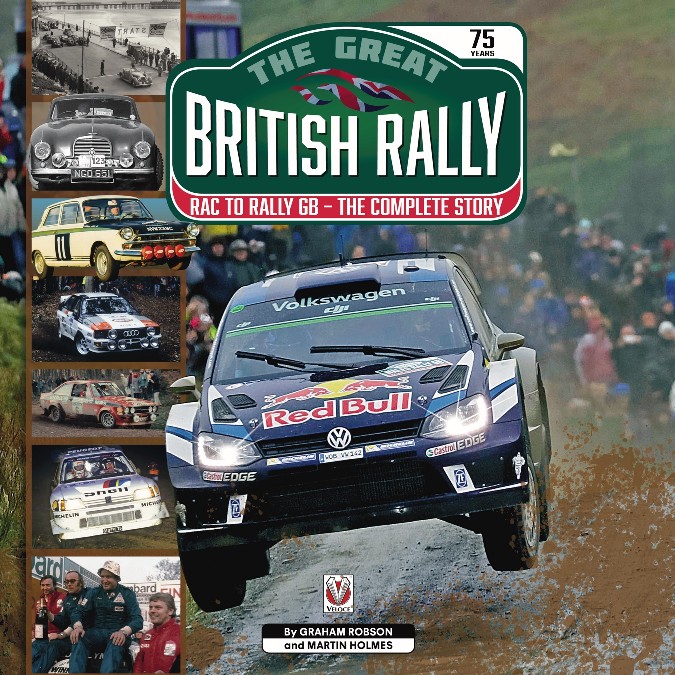
The Great British Rally - RAC to Rally GB - The Complete Story, by Graham Robson and Martin Holmes.
ISBN: 978-1-787113-68-8, £35.00 (+ P&P).
Published by Veloce Publishing Ltd, Veloce House, Parkway Farm Business Park, Middle Farm Way, Poundbury, Dorchester DT1 3AR (UK).
Tel: +(0)1305 260068.
E-mail: info@veloce.co.uk. www.veloce.co.uk.
Click here to order or see a sample
Ignoring what I wished the book to be, what is it actually like? A very nice book with plenty of contemporary photos and an easy to read storyline. The genesis of the rally is covered through to 2018, with a description of the contemporary rallying scene at the beginning, followed by a year by year description of each rally, the major points and competitors being covered. It could be argued that the pre-war events are a little lightly covered in comparison to the later events, but that might simply reflect the availability of information, plus that the event wasn't as important on the international scene at the time. What it is is a great overview of the changing face of rallying in this country over time. No other book that I've seen on the topic has covered quite such a wide period of time (well, there was one book on the Monte Carlo rally, but I've only heard of that, not seen it, so still technically correct!), and such a range of changes. The early photo's really do give a sense of what it was like at the time, and even if you didn't read the text and simply flicked through the pictures, you would still get a sense of how competition rallying has changed over time.
As well as highlighting the history of the rally GB, it also charts the development of world rallying. It shows what has been gained, but also what has been lost. No longer is the Rally GB really GB - it doesn’t go to England or Scotland any more, the number of stages are a fraction of what they were, and we’ve lost signature stages such as those in Kielder. But the Safari Rally will be rejoining the WRC soon, so perhaps in future some of those elements which made the rally stand out in the past can be seen again.
And one more thing - by basing the rally entirely within Wales and with entirely pay to access stages, an entire generation of potential fans had been lost to the sport. When you could visit some stages for free, and stood a good chance of seeing cars go past when you lived elsewhere in the country, casual fans could take their families and introduce them to it; with expensive access tickets, taking a chance on family interest isn’t worth it. By rotating the host city, you got the chance to engage a new fan base each time. When the rally started in Bath, I got to know that the sport existed, kicking off an interest and getting me to follow each year. Years later I visited the rally day at Cheltenham - you could keep fans from all over the country engaged. Today, most youth in the UK will never see the rally, it’s not on the news, and they probably don’t even know it exists. A whole new fan base has been lost, and the sport is poorer for it.
Rant over....
The authors themselves competed on the event, so the text benefits from a first person perspective and a deep understanding of what needed to be undertaken, without any excessive self-referencing. When reading the chapters on the 1980s, I couldn't help but remember William Woollard and the Top Gear Rally Report, essential viewing amd when you knew November was really underway. Plus waiting in a layby at the bottom of Brassknocker Hill in Bath, watching the cars go past on their way to the next stage. The Lombard RAC was an event in those days. This book does it justice.
Is it the complete story as the tag line suggests? Not quite - there were a couple of fatalities in early rallies which were not even mentioned in passing for example, but it is by far the most detailed and complete book on the history of the rally that I have yet seen. There are other books out there which have more pictures, but none which go back in history so far, so for that reason alone it has to be recommended.
Points/Errata
PG 22 - 1936 RAC - failed to mention first fatal accident.
PG 25 - Gives a picture of Jack Harrop in an SS100 (reg EHP 202), #28. But according to other sources, Harrop was #123 in 1937, and #158 in 1938.
PG 28-29 - 1951 RAC - failed to mention another fatal accident.
PG 31 - says that For 1953 Castle Combe airfield “was about to become a race circuit”: it became a circuit in 1950, and on pg 30 it states that “Castle Combe race circuit” was used in 1952.
PG 55 - 1963 RAC - Picture caption says Raymond Baxter drove #20 Rover P5 3 litre, but this picture is from 1962. In 1963 he drove #18 Reliant Sabre Six and retired. Mabbs drove #1 in 1963, but #9 in 1962.
PG 73 - 1969 RAC - Co-driver for Jonsson was Lidstrom, not Eliasson.
PG 81 - 1972 RAC - Makinen retired due to wheel stud failure/lost wheel, not engine failure.
PG 87 - 1974 RAC - Ballestrieri drove a Lancia, not a Fiat.
PG 120 - 1983 RAC - Typo, Lampi should read Lampinen.
PG 147 - 1993 RAC - Typo, Occell should read Ocelli.
PG 161 - 1998 RAC - Didn't mention Carlos Sainz's co-driver Luis Moya putting his helmet through the rear window in frustration at their retirement, all shown on TV......
Written 26th November 2019

Formula 1 All The Races - The First 1000 (A limited edition of 1000 copies), by Roger Smith.
ISBN: 978-1-787115-66-8, £65.00 (+ P&P).
Published by Veloce Publishing Ltd, Veloce House, Parkway Farm Business Park, Middle Farm Way, Poundbury, Dorchester DT1 3AR (UK).
Tel: +(0)1305 260068.
E-mail: info@veloce.co.uk. www.veloce.co.uk.
Click here to order or see a sample
And one which does exactly what it says in the title, covering the first 1000 World Championship Grands Prix (and limited to 1000 copies as well, so it will quickly become scarce). For each race there is a short race description, the pole position winner, the fastest lap winner, the top 6 finishers (although the top 10 from 2012 onwards - why not for all?) and lap leaders, with a liberal sprinkling of contemporary photos. At the beginning and end of each year is a short section of facts which gives a picture of the years events, and all of the races are also graded on a 6 point scale, based on the perceived importance of the race and what happened. It is the ideal book for flipping through and gaining an overview on the history of the sport. There were plenty of "oh yeah, I remember that!" moments when flipping through the latter half of it.
What it is not is the complete reference - there have been books in the past which covered the complete results, but these are not really being produced these days due to the number of races and the advent of websites which cover exactly that and don't need half a bookshelf to publish the data. But it is not trying to be that, and does not suffer for it. It should also be noted that it covers the first 1000 World Championship Grands Prix - the number would be somewhat higher if all of the non-championship events were included.
What is a nice touch is that after the final race there is a link given, active after the final race of 2019, to download a PDF of the rest of the results for the year, bringing it up to date and signing off at the natural end-point. This was a nice extra thought for the purchaser.
I kept finding that I spent longer reading the book than intended each time I picked it up - you always want to at least finish the year you are on, then find that time had disappeared. Which I think is a high recommendation for the book - there is a lot in it to read, and it keeps you focussed on it. The end of year list of "facts and folklore" are where most of the time can be spent reading, but it isn't a flowing narrative, instead a list of linked bullet points which get progressively longer as the years get newer - perhaps a reflection of there being more races for things to happen in as the years rolled by, and also more topics to cover given the higher levels of contemporary race coverage. Whether you like this book probably depends on what you want it for. If you want pure statistics and complete results, there are other books and websites out there. If you want descriptions of the races to go with that and the salient points of the season covered, you can find that for earlier seasons in some books, but not so easily for the later ones unless you have a complete run of Autocourse, which would be bigger still. If you want a book to cover all of that, although not necessarily in the same level of detail, then this will be one for you - it is positioned as a commemorative volume, which it is, although a possibly expensive one. And if you read it a lot, you get the added benefit of adding some muscle.....
Errata
PG 39, 44 & 50 - Typo - "Vittorio Jani" should read "Vittorio Jano".
PG 317 - 1986 facts: About Beatrice withdrawing that year - “the final foray into F1 by a USA-led team”. What about Gene Haas’ team which entered from 2016?
PG 351 - 1990 Mexican GP - Mansell passed Berger in the Curva Peraltada, not Peralta.
Spanish GP - why from the 1990s onwards is it listed as being at Cataluña, which is a region, when all other grands prix are listed as being at the city/town where they are located? For example, the 1951 Spanish Grand Prix is listed correctly as being in Pedralbes, which is part of Barcelona and thus also in Cataluña.
PG 399 - 1994 - “But for 1995 an engine partnership with Mercedes-Benz was already in place, a relationship that endured to this day.” McLaren spent two years with Honda engines, and this year with Renault.
PG 422 - The all-time wins list is wrong. Stewart had 27 wins, not 41. Clark had 25, not 27. Senna had 41 wins, not 31. Mansell had 31 wins. So the ** footnote should say Clark also won 25, rather than repeat Laura’s total.
PG 447 - malasian gp, typo.
Written 8th November 2019
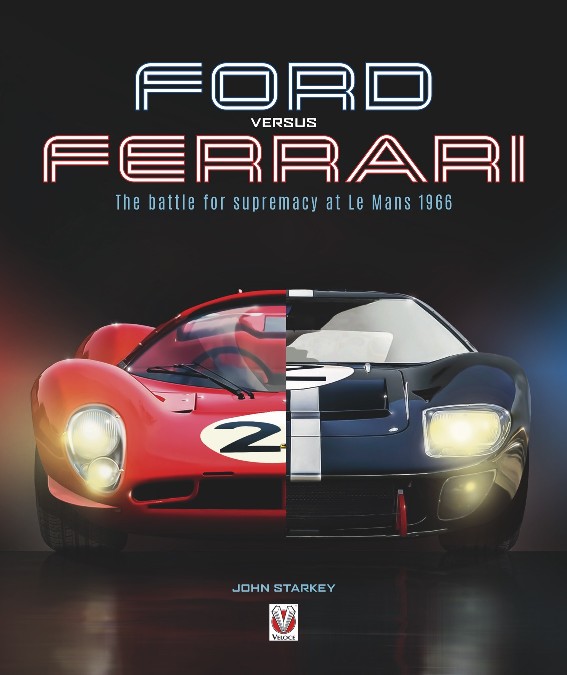
Ford versus Ferrari - The battle for supremacy at Le Mans 1966, by John Starkey.
ISBN: 978-1-787115-72-9, £15.99 (+ P&P).
Published by Veloce Publishing Ltd, Veloce House, Parkway Farm Business Park, Middle Farm Way, Poundbury, Dorchester DT1 3AR (UK).
Tel: +(0)1305 260068.
E-mail: info@veloce.co.uk. www.veloce.co.uk.
Click here to order or see a sample
The title is Ford versus Ferrari, but the story is overwhelmingly about Ford, it’s approach and the participants in its story. What is strikingly missing is the equivalent about Ferrari. If it is one against another, there are obviously two sides and two viewpoints, punch and counterpunch. The story would have a better balance if it also explored the opposition viewpoint, why they did what they did and when. There are quotes from Mauro Forghieri's book Forghieri on Ferrari, but these are not as detailed and exhaustive as the ones from participants in the story of Ford.
Despite the sub-title mentioning Le Mans 1966, the book also covers the the winning 1967 season, with a quick overview of the 1968 and 1969 winning seasons due to the GT40 winning Le Mans in those years too, although minus Ferrari as they withdrew from sportscar racing at the end of 1967. It is a less technical book than Ford GT - Then and Now, which covers some of the same story, but is a much cheaper overview of the Ford team, development and results achieved illustrated with great contemporary photographs. I thought that the epilogue at the end where the author raises a series of unanswered questions was a nice touch, as it highlighted as with any historical story that there is always more to find somewhere. Such as the odd story about "Ken Miles" (you'll have to read the book to find out!). A good book for a present as we are coming up to Christmas, for those who wish to find out more and are newer to the subject.
Written 14th October 2019
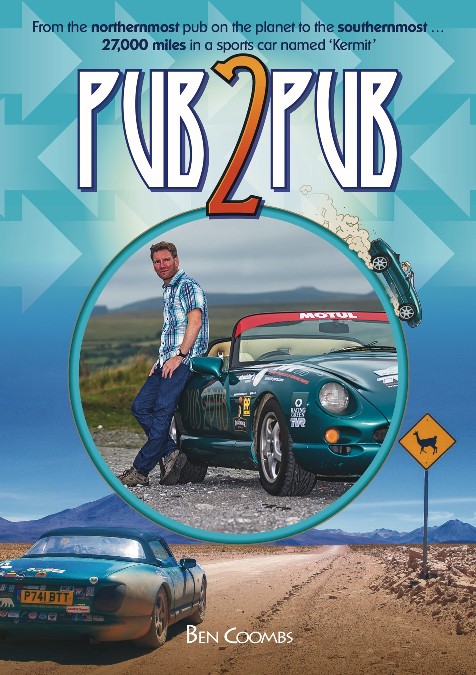
Pub2Pub - From the nothernmost pub on the planet to the southernmost... 27,000 miles in a sports car named 'Kermit', by Ben Coombs.
ISBN: 978-1-787113-60-2, £14.99 (+ P&P).
Published by Veloce Publishing Ltd, Veloce House, Parkway Farm Business Park, Middle Farm Way, Poundbury, Dorchester DT1 3AR (UK).
Tel: +(0)1305 260068.
E-mail: info@veloce.co.uk. www.veloce.co.uk.
Click here to order or see a sample
But a TVR is what was chosen, one named Kermit, but the driver was no muppet (sorry, couldn't resist that one. No Gonzo journalistic piece this......), even if the car was a bit of an animal. As the author himself admits, reliability isn't what they were known for, but this one was going to take him from the northernmost bar in the world to the southernmost, with only a couple of garage visits in between, and they weren't all for the TVR.
The book itself was one that grew on me. The first page was written in a more fictional style, and was a little confusing as it was discussing an ex-Soviet mining facility when they were quite clearly in Norwegian territory in Svalbard (aka Spitzbergen), but that was due to my lack of knowledge and was quickly solved by a Google search (the Soviet's bought a mine and settlement originally set up by the Swedes in the 1930s). Having started here, the narrative then jumps back in time to discuss the genesis of the idea, before proceeding onwards.
The book is firmly focussed on the journey, and so glosses over in parts the places that were visited. I felt that this was particularly true of the visit to Cuba, where the summary of the island went through a list of situations such as the Bay of Pigs invasion, was glowing over the spirit and defiance of the populace, but then completely fails to take into account that the “overwhelming odds”, isolation and difficulty are a result of the political decisions taken by a communist government which routinely spies on its own people and prevents them from running their own legal businesses. It jarred a bit when read - a little bit of a lack of perspective, where the interest in the classic every day cars seen as a result of the policies shaded the author from the causes. Cubans have spirit as he wrote, but they need to to survive; too many have had to flee.
Having said all that, the piece was followed by a much more thoughtful piece on New York, the skyline and its people. Perhaps it is just a case of viewing things through what you’ve experienced, things happening this century being much more raw and vivid in the mind, easier to recollect because you've lived through it.
And the mind is what this book is very much about, dealing with the darker sides of depression, and how the author overcame it and through the journey rediscovered himself. It is something that keeps coming back, an undercurrent through the narrative that threatens to disrupt the progress, but never gets there, as the author deals with the problem and identifies the causes. If nothing else it is a tail of how you really can make your dream come true, whatever the odds, and especially if those odds come from within. There was a bigger journey undertaken than one of 27,000 miles.
To be fair, there were many other considered pieces as well, coupled with amusing vignettes on dealing with the petty bureaucracy of Central America while staying sane and retaining a sense of humour. And absolutely stunning pictures from South America - there are 30 inserted colour plates documenting the journey. If nothing else, the book will give you plenty of off-beat ideas of what to visit should you ever head to some of the places visited.
Written 17th September 2019
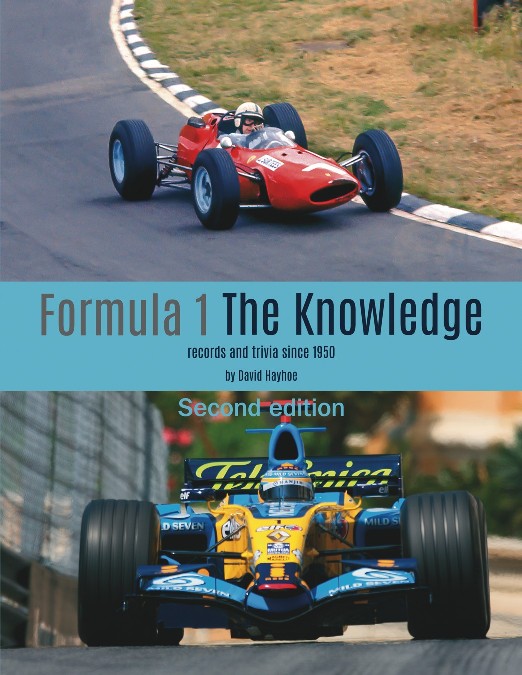
Formula 1 - The Knowledge (2nd Edition), by David Hayhoe.
ISBN: 978-1-787112-37-7, £55.00 (+ P&P).
Published by Veloce Publishing Ltd, Veloce House, Parkway Farm Business Park, Middle Farm Way, Poundbury, Dorchester DT1 3AR (UK).
Tel: +(0)1305 260068.
E-mail: info@veloce.co.uk. www.veloce.co.uk.
Click here to order or see a sample
In that book and a subsequent edition was a chapter called Records and Trivia, and this book is effectively that chapter, but massively, massively more. This is not going to be a book which you sit down to read cover to cover, as there is no narrative, it isn't trying to tell you an overarching story, but it is the largest selection of statistics, coincidences and small stories on F1 that you will find, complete from the beginning of the World Championship in 1950 until the end of the 2018 season. You want to know all constructors who have ever had a pole position? Easy...... All the different engine manufacturers? Sure.... All the F1 drivers who have written their own books or have been in trouble with the law? Yep, covered. Complete list of all the F1 technical regulation changes? A whole appendix devoted to that.
In summary, it is the ultimate coffee table book for those with any interest in Formula 1. Leave it on the coffee table, and each time you sit down with a hot drink, pick it up, flick to a new page, and read a few things - you will learn something new. Will probably take longer than you intended. And if you don't feel up to reading, there is a nice photo section to flick through too. It will also be good exercise - at 544 pages of good quality paper and with a sturdy hardback cover, there is a lot to lift around. I'll be idly flicking through this one for years, probably until the next updated one appears (as this is the second edition, 2022 is when the next one is due at the current update schedule!).
Written 20th May 2019
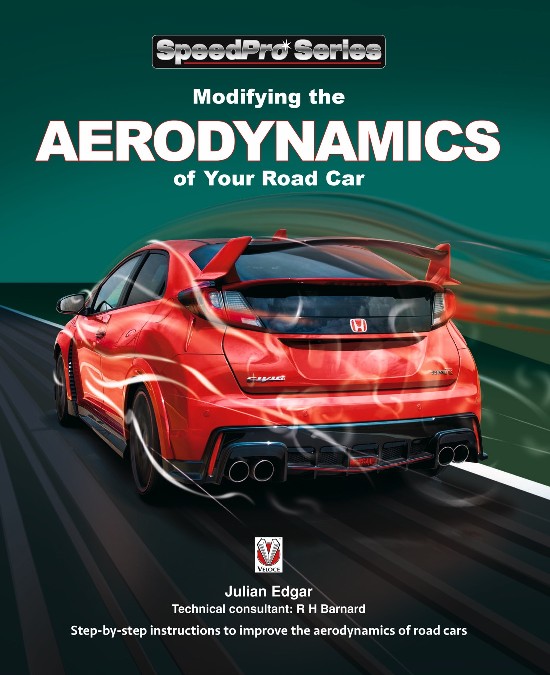
Modifying the Aerodynamics of Your Road Car, by Julian Edgar.
ISBN: 978-1-787112-83-4, £35.00 (+ P&P).
Published by Veloce Publishing Ltd, Veloce House, Parkway Farm Business Park, Middle Farm Way, Poundbury, Dorchester DT1 3AR (UK).
Tel: +(0)1305 260068.
E-mail: info@veloce.co.uk. www.veloce.co.uk.
Click here to order or see a sample
Although it necessarily covers some aerodynamic theory, it is a much more practical book than theoretical, showing what to measure around your car to see how the aerodynamics affects things such as stability, handling, fuel economy, noise and engine efficiency. And it does it well – there are lots of practical examples, with lots of photo’s to compare against should you wish to do it yourself (there are lots of photo’s of different air flows around different cars using wool tufting, so find one closest to what you observe), and it is based on road cars, so there is less wing theory than in the Competition Car Aerodynamics by Simon McBeath also reviewed last year.
However, when reading the book, I did get the feeling that although the title of the book is “Modifying the Aerodynamics of your Raod Car”, it is more about how to visualise what is happening around your car. There are examples of what the author and some others did to modify a number of cars, but these formed a smaller part of the text. The examples tend to reinforce points made in the text on how certain features can change aerodynamic behaviour, but to really be a book on modifying your car, a bit more on the pitfalls and what to do when attempting things yourself would perhaps make it a more complete text, and match up more to the title.
There were a couple of other things which nagged at me a little. Firstly, the book ended very abruptly – the final chapter discusses a modification done to a car, and then goes straight into the references – it had me checking to see if I had missed anything, as there was no obvious conclusion. Also, on page 21, the author works out for a Honda Insight Gen 1 travelling at 100 km/h that the drag force observed is 213 Newtons. It then divides the result by 9.81 to get kilograms-force, and says that 21.8 kilograms force is required to push the car forward.
This had me puzzled. 9.81 is I suspect g (the value is not explained, just used), the acceleration due to gravity at sea level, but this is a force acting vertically, there is no horizontal component if the car is on a flat road. It makes more sense for the lift calculation, as that does act vertically, but why horizontally? So I did some further research, and established that when the term kilogram-force is used, what is really meant is “the amount a kilogram would weigh on earth”, as the kilogram is a mass rather than a weight. So what the author is doing here is establishing a force, and then calculating the effective mass needed to create the force if it we imagined that it was acting vertically instead. There are assumptions of knowledge here which could perhaps be further explained.
One further point - the clay erosion method described in the book may be illegal if used on the front side windows and tested on the road in the UK, as any tinting applied must let through 70% of light, and from the picture in the book where this exact scenario was used, it looks like more than that is blocked after application. It would work well on the rest of the car body or rear windows though.
In summary, this is a great practical guide to road car aerodynamics, simply explained, and backed up with plenty of references to industry sources and papers for those who want to find out more. The author has consulted many industry experts on the subject, and has used the techniques described to great effect. For those who want to usefully do something to their car which is more than just for aesthetics, it is a good place to start.
Written 27th December 2018
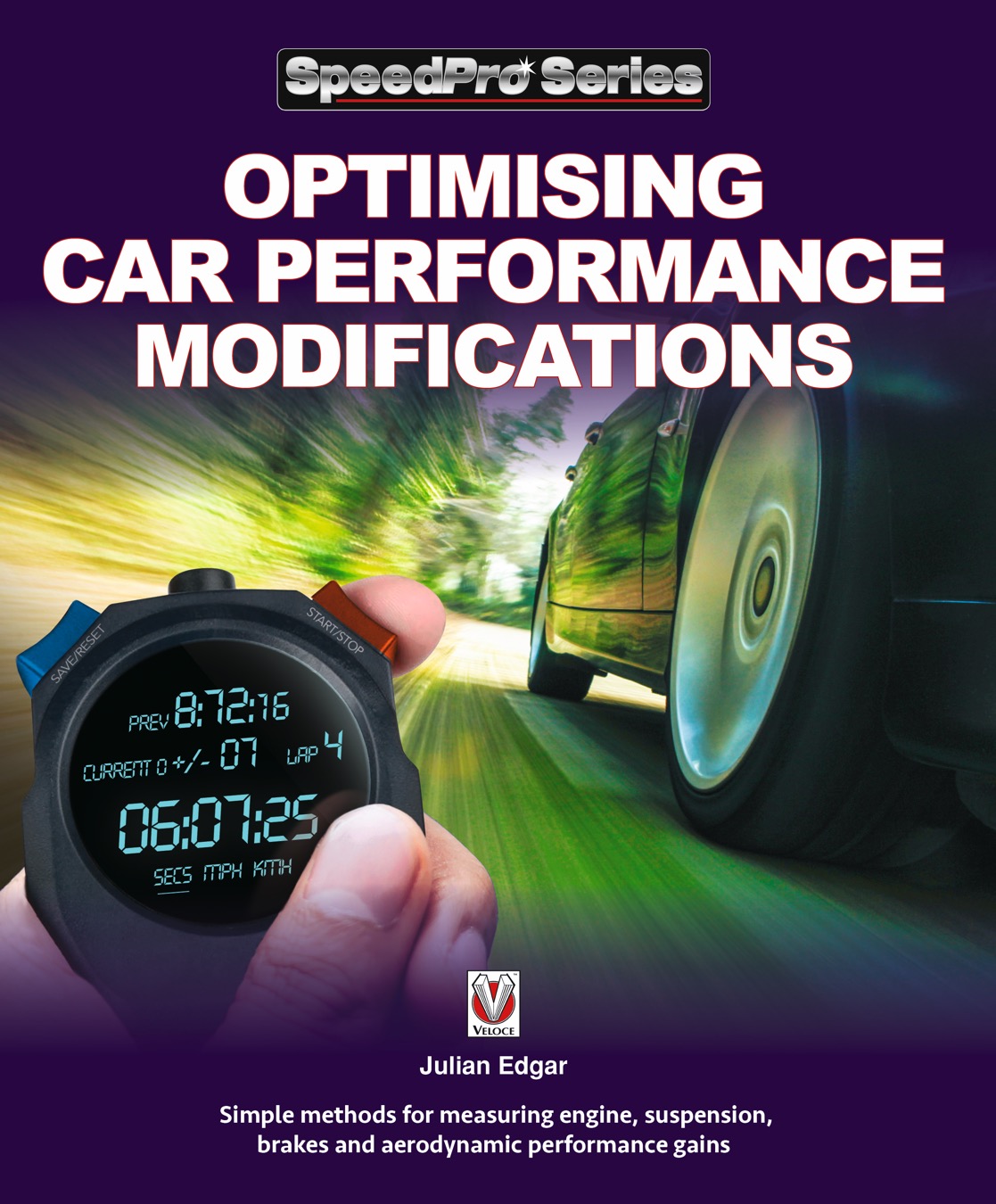
Optimising Car Performance Modifications, by Julian Edgar.
ISBN: 978-1-787113-18-3, £14.99 (+ P&P).
Published by Veloce Publishing Ltd, Veloce House, Parkway Farm Business Park, Middle Farm Way, Poundbury, Dorchester DT1 3AR (UK).
Tel: +(0)1305 260068.
E-mail: info@veloce.co.uk. www.veloce.co.uk.
Click here to order or see a sample
So I might not be testing performance modifications to my car, but I can test changes to its behaviour, such as what happens when the car is fully loaded with a bunch of blokes and you hurl it round a corner. And I thought that the best way to review this book is to try some of the things out. So first stop, lets find the factory engine performance specs to compare against, and download the app "Physics Toolbox Sensor App", which as well recording things such as acceleration in g, also mails you the results as a CSV file.
And then find a quietish road, not so easy in a town. Set the phone up, lay it flat, switch on the app. Check the mirror, move off, and move along at idle. Hit the record button, hit the accelerator, and watch the revs rapidly build up. Almost at the red line, hit the off button, and then drive along as normal. Once stopped, mail the resulting data. Doing it in first gear definitely records the highest acceleration figures, but everything is so rapid, so I can see why the author recommends a passenger as a data recorder, or a video camera. I only got the start and end rev values...... (800-6000 in my case).
So what did the data look like? I opened up my spreadsheet and imported the data. The first problem was formatting it - Excel didn't like times which included a date, and a time down to the ten-thousandth of a second. Removing the date and adding a custom cell type seemed to solve that. Deleting the data for overall g value, and acceleration in the x and z axis left me with what I needed. But what on earth am I then seeing?

The left part of the graph reflects starting the app – I started it then accelerated, the phone moved when I touched it, all affecting instantaneous acceleration measurements. The right hand side of the graph is also a bit of a mess, but then also reflects the difficulty of trying to close the recording when getting very near to the redline of the engine on an open road. And there is no way I recorded anything like -0.8g. But there is information there – the car initially accelerates constantly, increases acceleration as the turbo kicks in, peaks, and then acceleration falls off – and all over in a roughly six second time window! It should also be borne in mind that I have ignored the author's sound scientific advice in this case – it was only over one run, and you need a second to average out conditions. But this real world sample does at least mirror the manufacturers specs – the torque curve should increase linearly, flatten off, then gently fall away. And it was fun. Equally, the problem may have been the app I used – perhaps I should try the linear acceleration option instead of the g-meter. The author mentions that you should test rather than assume knowledge, and that goes for the tools as well. But what should I try next?
Measuring air intake pressure drops and back pressure from the exhaust, but this will involve making some holes in various places to get the readings, and I'll need some equipment. Family car – I'll pass on this.
Next – suspension, and testing the natural frequency of your suspension. The book recommends an app, but the aforementioned physics app will do the same job. I had some time to spare, so while waiting in a car park, I placed my phone over the centre line of first the rear, and then the front wheels, and bounced the car up and down. Ignoring the strange looks from others who were also waiting, and who didn’t dare ask this stranger what he was doing, I again recorded the data, and sent it home for later analysis. Loading it into Excel and plotting the results, and I have a nice set of oscillating lines, giving me a front value of 1.927 Hz, with an identical matching one at the rear. I was impressed – a very simple measurement had given me a figure which was right in the ballpark suggested by the author. My car has firmer suspension that the two examples in the book, but then it is a larger car with more weight to support, so you could expect that.
The book then goes on to testing aerodynamics and loads, but I won't be adding any wings or vortex generators to mine, so one more to pass on. Engine management? Interesting, but have you seen the security they put in to the chips these days to try and stop this? So no, not for me. The final section was some of the authors own experiences, with ideas on how to do cheap modifications to increase power and performance, both with the engine and braking. Some interesting ideas there.
The book itself is written in an easy to understand manner, with the concepts and ideas easily conveyed. It encourages you to try things, but to do so in a way which gets you useful information about the changes to your car. It is not going to tell you what to change to improve it (well, it does make suggestions, but you should test them in the context of your car), but it does tell you how to test it meaningfully. The absolute numbers you get may not be as accurate as possible, but it is the comparisons that matter. I still won't be modifying my car, but I had fun following the ideas mentioned and finding out. A shortish book, but one which gets you comfortably into the subject, and crucially gets you thinking about it.
Written 18th September 2018
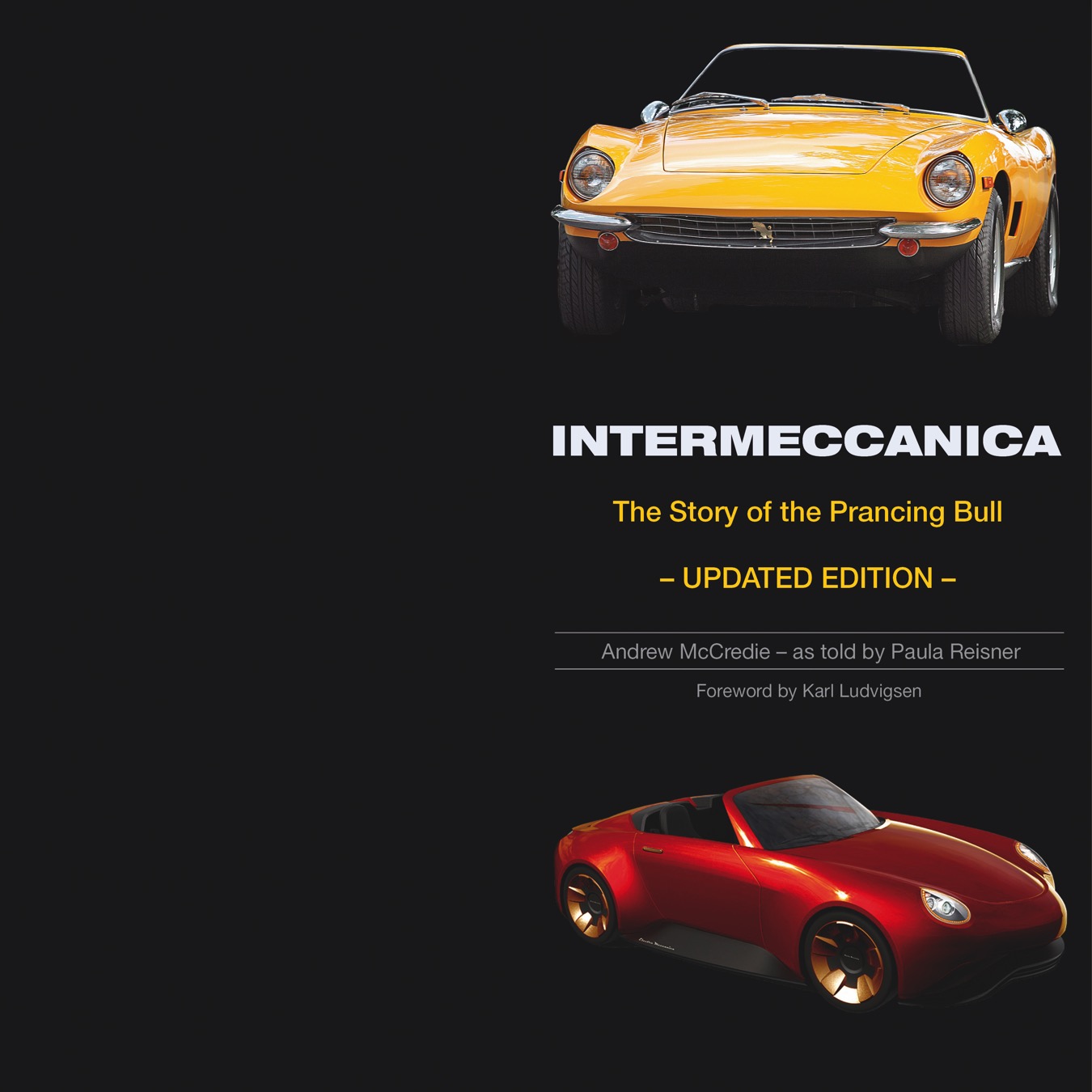
Intermeccanica - The Story of the Prancing Bull (Second Edition), by Andrew McCredie and Paula Reisner.
ISBN: 978-1-787112-53-7, £45.00 (+ P&P).
Published by Veloce Publishing Ltd, Veloce House, Parkway Farm Business Park, Middle Farm Way, Poundbury, Dorchester DT1 3AR (UK).
Tel: +(0)1305 260068.
E-mail: info@veloce.co.uk. www.veloce.co.uk.
Click here to order or see a sample
The driving force behind Intermeccanica in its various guises was Frank and Paula Reisner, husband and wife, and the author wrote the book in conjunction with Paula, which lends a lot of insight into what happened and why. It gave the author access to many documents which might not otherwise have been seen (and some are reproduced in the book), together with an idea as to what Frank felt about the things that happened. And lots of things happened - Intermeccanica was one of many small sportscar manufacturers in the 1960s, and the travails of such an operation are very well explained - chance meetings, decisions taken in good faith which in retrospect turned out for the worst, all are covered. For those used to the stories of more known companies such as TVR, much will be familiar, especially given that the history of the two companies intersected through Jack Griffith - TVR building a lightweight car featuring a large American V8 engine (TVR Griffith), much like the Intermeccanica offering of an American V8 clothed in Italian bodywork. A chance strike of dockworkers in the US pushed TVR into financial trouble, and one companies' trouble is anothers opportunity - Griffith went into business with Intermeccanica.
The company morphed with the times, changing each time the company changed countries - it started out in Italy, relocated to California, before moving finally to Canada. It changed from developing sportscars of its own into a developer of well regarded Porsche replicas, before perhaps returning to the past as part of the future, developing its own electric vehicle. But this is perhaps where I have one exceedingly minor point of complaint with the book - in the appendix, which is very detailed, it lists every car that Intermeccanica built while based in Italy, but there is no equivalent list of cars that were built in the US or Canada. Perhaps this is because most of those were replicas. It would also be nice if there was an additional column to the table stating where each car ended up if known - there are enthusiasts/owners clubs out there for the cars, so I'm sure that the information is out there. It would have made the book that little bit more definitive.
Having said that, it is a good read, and it ties together various characters across many countries and many companies. There are plenty of images, contemporary and modern, and the whole build process from wooden buck, chassis layout, engine installation to production line is covered. But I must apologise to the publisher for being a little late with this review - there was more reading in this book than I expected....
Errata
PG 30 - Typo, "Stranguellini" should read Stanguellini.
PG 179 - Typo - Rod Trenne was designer for Panoz, rather than Panos.
Written 30th July 2018
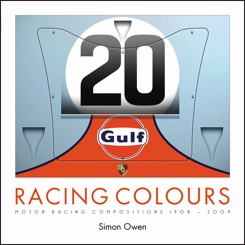
Racing Colours - Motor Racing Compositions 1908-2009, by Simon Owen.
ISBN: 978-1-787111-94-3, £14.99 (+ P&P).
Published by Veloce Publishing Ltd, Veloce House, Parkway Farm Business Park, Middle Farm Way, Poundbury, Dorchester DT1 3AR (UK).
Tel: +(0)1305 260068.
E-mail: info@veloce.co.uk. www.veloce.co.uk.
Click here to order or see a sample
First published in 2014, Racing Colours by the late Simon Owen has been republished in paperback. At the time of his passing, Simon Owen was preparing a book of his digitally created images which included a chapter on his techniques for creating them - the book was taken through to publishing as a memorial. Each image consists of a race number and the part of the car the number is placed on, with impressive amounts of detail showing the various ducts and finishing lines around the cars. Accompanying each image is a short text quote related to it in some way, or to the people who drove and designed it. The quotes come from a large number of sources, including books and magazines, and not all UK based, so there is sure to be something new here for everyone.
It isn't a history book, although it covers a wide spectrum of racing history. The quotes are at once hooks to draw you in, as well as being thought provoking, bringing home the passion, exhilaration and grief in motor racing. The images show that although things change, some things still remain the same - across the 90 years of motor racing covered, all cars still have a race number, are still identified in the same way. The introduction says that the book is a reflection of the perception of the author, so as a memorial it has achieved what it intended.
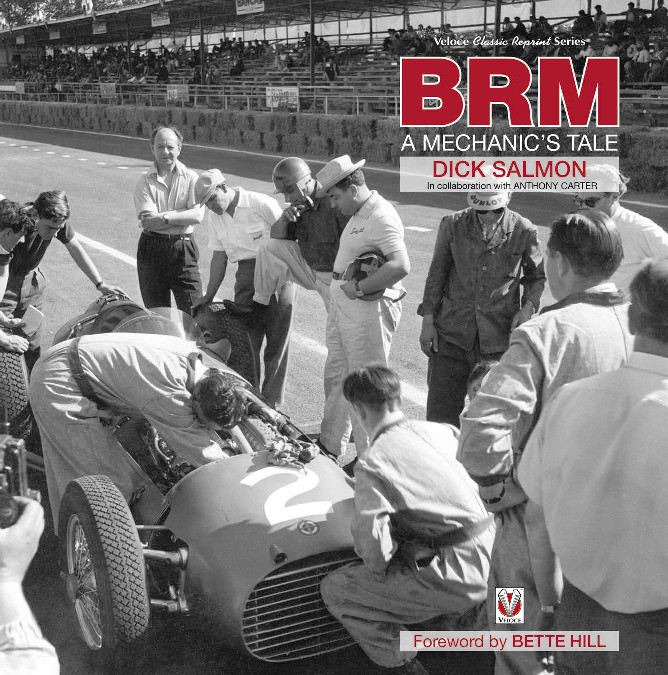
BRM - A Mechanic's Tale, by Dick Salmon.
ISBN: 978-1-787112-27-8, £30.00 (+ P&P).
Published by Veloce Publishing Ltd, Veloce House, Parkway Farm Business Park, Middle Farm Way, Poundbury, Dorchester DT1 3AR (UK).
Tel: +(0)1305 260068.
E-mail: info@veloce.co.uk. www.veloce.co.uk.
Click here to order or see a sample
The book was first published in 2006, and this edition is a new paperback. As well as a lot of text to read, there are plenty of snapshots illustrating the pages, personal photo's unseen elsewhere, passes, advertising, and much other period material. It is an evocative insight to the rise, achievements and subsequent decline of a great racing team, as well as to drivers such as Graham Hill and Jo Bonnier. It also drives home how different a race team was then - BRM wasn't a small team, but is tiny compared to even the smallest of modern outfits, and they had to look after more than two cars at a meeting, and customer cars and engines, and they took longer to ship around. A different world. A good read.
Errata
PG147 - Typo - "Bruce McClaren" should read "Bruce McLaren".

Lancia Delta Integrale, by Peter Collins.
ISBN: 978-1-787110-76-2, £35.00 (+ P&P).
Published by Veloce Publishing Ltd, Veloce House, Parkway Farm Business Park, Middle Farm Way, Poundbury, Dorchester DT1 3AR (UK).
Tel: +(0)1305 260068.
E-mail: info@veloce.co.uk. www.veloce.co.uk.
Click here to order or see a sample
There are differences - the book isn't attempting to be a pure rallying story. The Lancia Delta didn't start out intended for rallying, but the 4WD version was the right car at the right time when Group B was abolished, and it was rallying requirements which then drove the development of the car, doing so much to change the perception of Lancia in the UK (these were Lancia's when I was growing up - everything that came after, or any other road model was boring....). So as well as pictures of the rally machines, there are plenty of pictures of road cars, as well as an interesting section detailing what to look for if you are looking to buy one (what faults might happen, what sounds to listen out for, what a particular rattle means), together with guide prices for the different versions from good to less good condition. Concept cars based on the same chassis are also covered.
Any criticisms? A couple of minor ones perhaps - the eight page photo section on Integrales today in historic rallying could do with captions, and I missed the equivalent table from the Lancia 037 book which detailed the rally results achieved by the car. The book doesn't do quite the same level of detail as the 037 one when recording which car achieved what, but then there were many more chassis used by Abarth and Jolly Club, and it does list the car registrations used. Like the Ford Focus book reviewed last month, it doesn't cover customer cars either, maybe because there were so many, but key achievements are detailed. It is a great addition to the story of Lancia, and a great record of these spectacular cars which defined an era of rallying.

Ford Focus WRC - The autobiography of a rally champion, by Graham Robson.
ISBN: 978-1-787110-20-5, £35.00 (+ P&P).
Published by Veloce Publishing Ltd, Veloce House, Parkway Farm Business Park, Middle Farm Way, Poundbury, Dorchester DT1 3AR (UK).
Tel: +(0)1305 260068.
E-mail: info@veloce.co.uk. www.veloce.co.uk.
Click here to order or see a sample
The book sells itself as the autobiography of the Ford Focus WRC, but the book doesn't do the level of detail seen in the Lancia 037 book reviewed earlier this year, as it only concentrates on the results for works cars and M-Sport. The number of customer cars sold each year is mentioned, but they are not identified, and no results are given or customers identified, so those wishing for an equivalent history of this car are still waiting. Also missing was an equivalent level of technical detail, going through the changes on a rally by rally basis, or even year by year. Some changes were mentioned, but they were light in comparison to the Lancia book. Maybe it's because it is just too recent for M-Sport to let the details out, but there are those customer cars to go and have a look at and consider. There were no technical diagrams, and apart from a couple of engine bay shots, no technical pictures explaining the componentry or changes after some for the engine, transmission and suspension for the very first model. It very much concentrates on the results obtained.
There are a few questions raised which weren't quite answered, for instance, what about Pipo Moteurs? There is a self-contained inset box describing the well known Cosworth on pg 58, but there is nothing on this not nearly so well known French concern. They took over engine development responsibilities, and are important to the story, but their contribution thus seems overlooked, and less celebrated, and I would have liked to have known more.
Having said that, there are good descriptions of the main M-Sport characters, and crisp, clear pictures showing the car with the varied liveries over the years. It also describes how M-Sport evolved, moving out of the original small premises and into their now much larger and much developed motorsport centre. It is as much a history of M-Sport as it is a history of the Focus.
It's an interesting book, and I liked reading it, I just think it suffers if I compare it against the Lancia 037 book. Having said that, most would. It's written by a respected author who had access to Ford archives which are not generally available to others, and is worth reading. There are details about people such as Christian Loriaux which you would be hard pressed to find elsewhere.
Just in case you are by now thinking that that this reviewer is simply biased against Ford and prefers Italian machinery based on previous reviews, this isn't the case. It's winter now, and I'm still using the Ford Focus WRC woolly hat I got from the 1998 Rally GB show at Cheltenham race course...
Errata
PG 96 - Rallye Catalunya "based in Lloret de Mar, southern Spain". Should read north-eastern Spain, as it is 100 km from the French border.
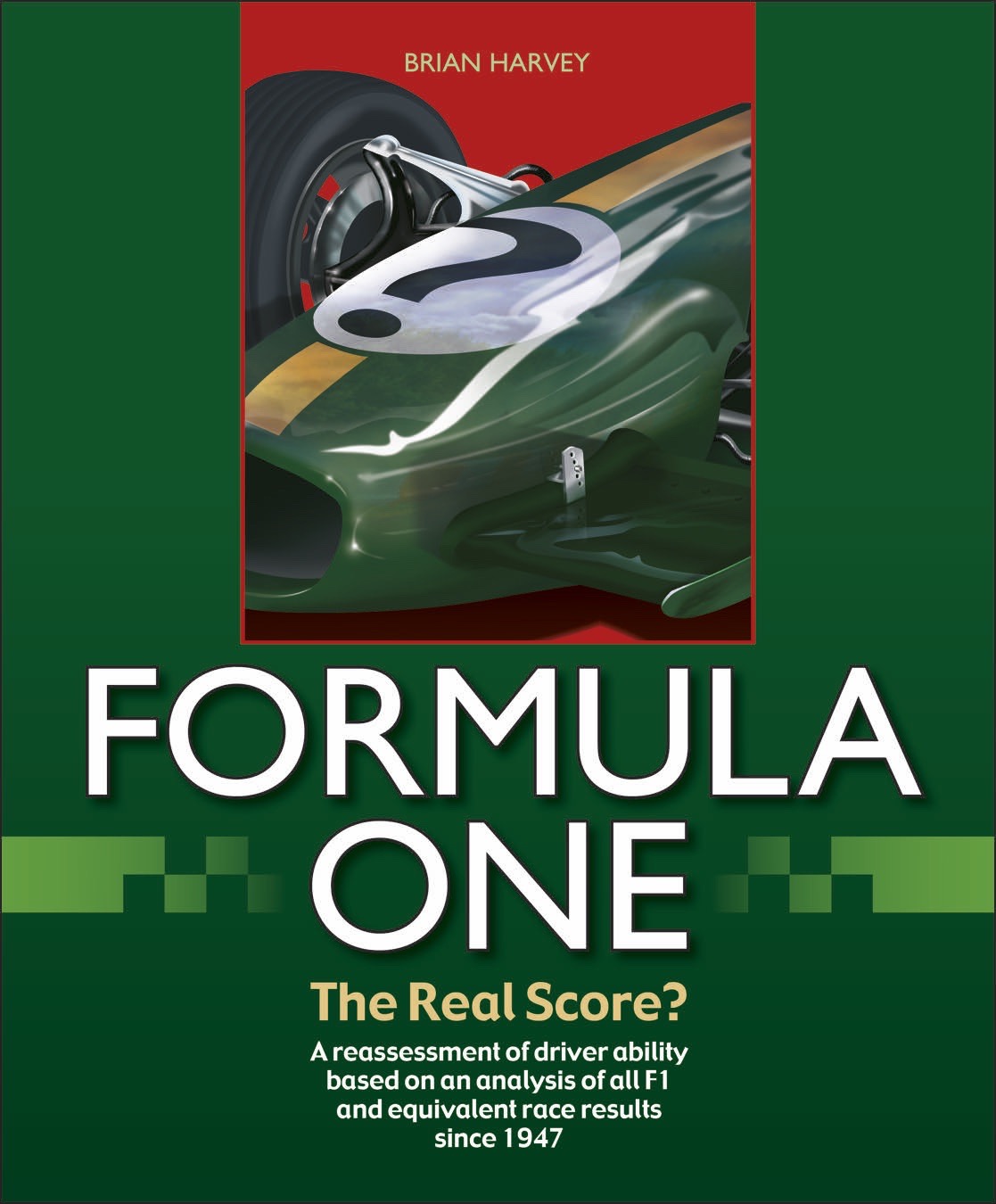
Formula One - The Real Score?, by Brian Godfrey Harvey.
ISBN: 978-1-787110-27-4, £45.00 (+ P&P).
Published by Veloce Publishing Ltd, Veloce House, Parkway Farm Business Park, Middle Farm Way, Poundbury, Dorchester DT1 3AR (UK).
Tel: +(0)1305 260068.
E-mail: info@veloce.co.uk. www.veloce.co.uk.
Click here to order or see a sample
But if you take a closer look at the 1955 season, for example, there may have only been seven World Championship Grands Prix (or Grands Epreuve as they were sometimes known - Argentina, Monaco, Indianapolis 500, Belgium, Netherlands, Great Britain and Italy), but there were actually 24 Grands Prix that year, as there were 17 non-championship races, races which is some cases were of greater stature than the Grands Epreuve. For example, Stirling Moss, who competed in six Grands Epreuve, also competed in six non-championship races, doubling the number of races that he actually competed in. If all F1 Grands Prix were considered, how would that affect the statistics? That is where this book comes in.
It aims to consider all F1 races and their equivalents (but makes no mention even in passing of the Aurora F1 series, so misses the only woman to have won a F1 race - Desire Wilson), and assigns them a rank of importance. Having done so, it then goes through year by year all of the races it is considering, giving a short result and description of all the major races, and a summation for each year. As you read through the book you get a feel for the authors preferences, but that is no bad thing - the descriptions are accurate, and interesting conclusions are drawn. There are also two interesting photo sections, which show how F1 design changed over time, and cover drivers not normally seen, such as Jean Pierre Wimille, who lost his life before he could trouble the world championship statisticians.
The book is an antidote to the endless stream of F1 statistic/results books which only ever cover the world championship races - the ones you are usually given by well meaning relatives at Christmas because they were seen on the shelf in the high street. It's almost that time of year again, time to drop some hints.....
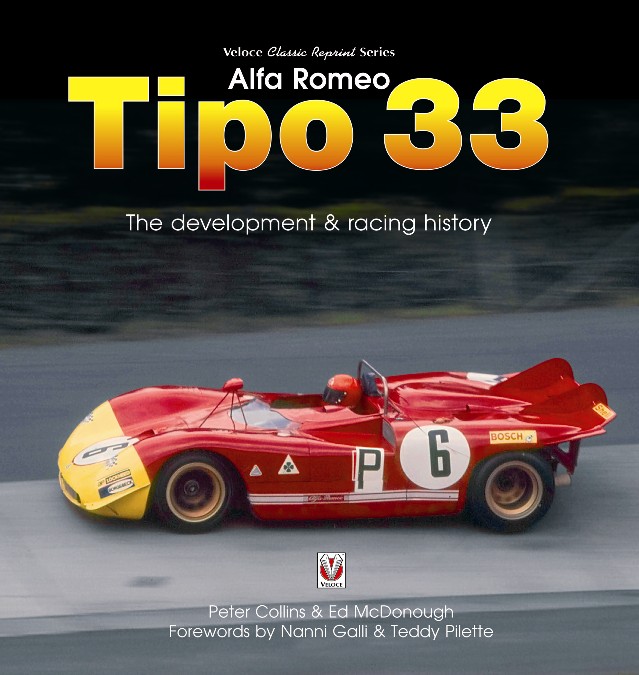
Alfa Romeo Tipo 33: The development and racing history, by Peter Collins and Ed McDonough.
ISBN: 978-1-787111-31-8, £45.00 (+ P&P).
Published by Veloce Publishing Ltd, Veloce House, Parkway Farm Business Park, Middle Farm Way, Poundbury, Dorchester DT1 3AR (UK).
Tel: +(0)1305 260068.
E-mail: info@veloce.co.uk. www.veloce.co.uk.
Click here to order or see a sample
The Tipo 33 lasted over a decade, but its life story raises an almost philosophical question - when is a car model still the same car model? If you start with one car, and over time change the chassis (more than once), the engine (likewise), the bodywork, and other sundry details one by one, is it still the same model at the end? All of this happened through the life of the T33, as it morphed from a classic curved 1960s sportscar into a slab-sided 1970s prototype. Each was called a T33, although there were numerous sub-model classifications, based on engine type (SC for Turbo, 12 for twelve cylinder) and chassis construction. And there were road cars and concept cars. All are covered within these pages.
The story is well sprinkled with anecdotes from drivers and test drivers, shedding light on how the car was viewed in period, although possibly coloured by the passing of the years, something the authors highlight themselves as they consider other possibly contradicting views. It could have done though with a little less use of "told the author" - that should be a given unless the quote is being taken from elsewhere. But that is a minor note from an otherwise informative read.
And one which is also well illustrated, with plenty of pictures (over 400 according to the blurb) of all the models highlighting the metamorphosis from promise to a world championship winner. With all the detail in this book, one wonders what extra could possibly go into a more extensive second book detailing the chassis histories which the authors reference as an effort for the future, which is probably why one hasn't yet appeared - the authors did a fine job the first time around.
Errata
PG44 - "Lucian Bianchias" - should read Lucien Bianchi.
PG95 - "one place ahead of Alfa driver, Elford, who was in a " - what? Sentence never finished.
PG206 - Sirius, Vega, Rigel and Aldebaran aren't just Italian names for stars - the same ones are used in English!
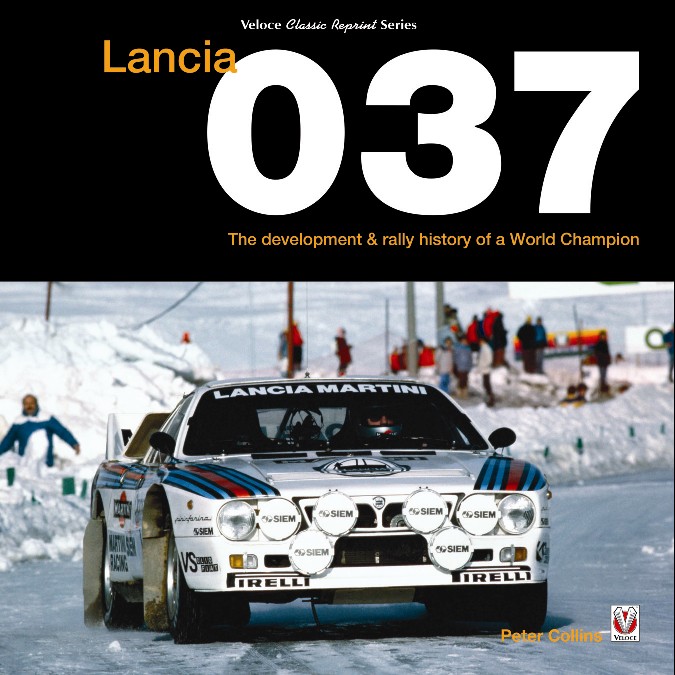
Lancia 037: The development and rally history of a World Champion, by Peter Collins.
ISBN: 978-1-787111-28-8, £45.00 (+ P&P).
Published by Veloce Publishing Ltd, Veloce House, Parkway Farm Business Park, Middle Farm Way, Poundbury, Dorchester DT1 3AR (UK).
Tel: +(0)1305 260068.
E-mail: info@veloce.co.uk. www.veloce.co.uk.
Click here to order or see a sample
And so this book was one to look forward to, part of the Veloce Classic Reprint series, covering a car of which I had previously read little, a stop-gap car which lived longer than intended, and achieved more than perhaps expected. And it didn't disappoint - the book details the gestation of the car, illustrated with copies of homologation papers, original technical drawings, copious photographs and very readable text. The author had extensive access to chief engineer Sergio Limone, and quotes comments extensively, as well as having comments and quotes from drivers such as Miki Biasion and Markku Alen, and pictures and documents from company archives. This is a book which all books covering a rally car should aspire to.
I liked the fact that there was a lack of hyperbole when describing the car and the results - the author had no need to use effusive words to emphasise results, when what was achieved in the context of the era was obvious in itself. The narrative is also not restricted to just rallying, and documents the participation of the car in various hillclimbs, Jim McGaughay's 037 based Special GT (a Toleman F2 chassis featuring a BMW engine, clothed in genuined 037 bodywork), as well as the road cars, coupled with a chassis list which states whether they were road cars, competition cars, and when known where they ended up.
The 037 overlapped with the Lancia Delta S4, and the origins of the car and the gradual change over is also covered. But full details of that is another story, and that is being published in November.....
Errata
PG 75 - "Andrea Zanussi, partnered by Bernard Chenne". According to pg 204, and other sources, he was partnered by A.Bernacchini.
PG 84 - Says that Pace rally was October 6th, should be 16th (as in table on pg 205)
PG 118 - Andruet's first win was the Rally du Rouergue on the 21st May, not Rally de la Baule.
PG 123 - Comment for photo of Biasion in Ypres '83 gives car reg, but this was for the Zanussi entry as stated on pg 122.
PG 160 - Rally Catalunya, says that Pons & Mandelli finished in "fifth and sixth places". Should be 4th and 5th, as per table on pg 210.
PG 206 - Missing Alen & Clarr from Costa Smeralda result list. Missing Rallye de la Baule & Andruet's win. There are other points from the main text not included here.
PG 207 - Blanc/Bubloz started #18 on Rally della Lana, not #6. Missing entries on 1985 Rally Terme di Casciana, 1985 Rally della Lanterna, 1985 Rally Città di Sassari, 1985 Rally di Pescara.....
PG 214 - Lists Criticos as #27 in Safari Rally, but photo on pg 185 confirms that Hellier was #27
PG 216 - Bianchi listed as #38 for 1986 Rally d'Antibes, was #18.
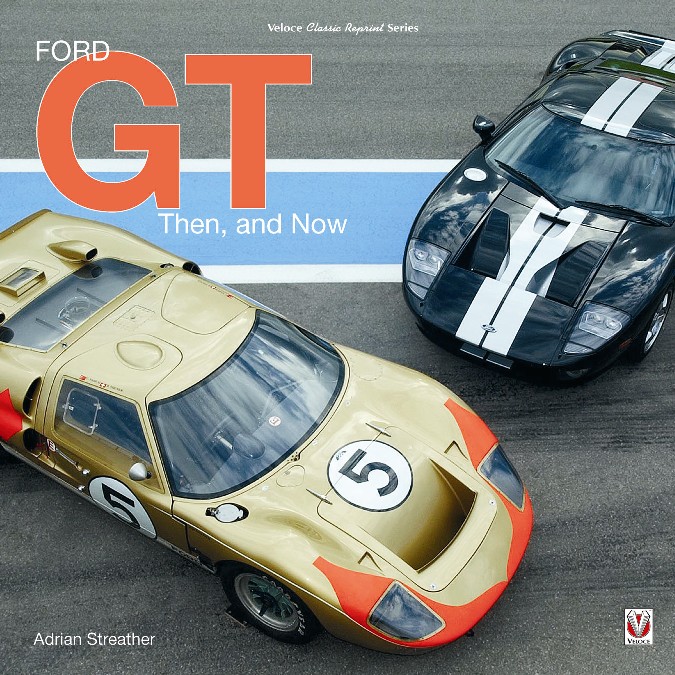
Ford GT: Then and now, by Adrian Streather.
ISBN: 978-1-787111-26-4, £45.00 (+ P&P).
Published by Veloce Publishing Ltd, Veloce House, Parkway Farm Business Park, Middle Farm Way, Poundbury, Dorchester DT1 3AR (UK).
Tel: +(0)1305 260068.
E-mail: info@veloce.co.uk. www.veloce.co.uk.
Click here to order or see a sample
At the time of publishing, the new Ford GT hadn't been raced, so it only covers the design and construction processes for it, and as there is so much good stuff on the original racing history, the book feels slightly unbalanced, probably more so knowing that the new Ford GT was raced. Mark VDS Racing won the 2009 Spa 24 Hrs with one, and one won the first ever FIA GT1 World Championship race at Abu Dhabi in 2010 (Roman Grosjean and Thomas Mutsch in a Matech entry). Hence I was going to suggest that the book could have benefitted from a revision rather than a simple reprint, but then I noticed on the last page of the book it documents a modern Ford GT replica which was inspired by the first edition of the book and was finished in 2016. If the first edition could have been updated, why not go the whole distance? Ford themselves created a new carbon fibre Ford GT which raced at Le Mans in 2016 and could have been mentioned, although admittedly this is a new from the ground up creation, and has no link to the original beyond being a Ford and having the same name.
The book doesn't just cover the factory Ford GTs created, but also goes on to document the numerous other companies which built replicas, or cars based on the original, which is something not often seen elsewhere. It also attempts to document some of the chassis histories, explaining how for some of the, two cars with the same chassis number can quite reasonably exist, and couples this with numerous photo's. It was informative to read how the author documents and classifies cars for historic racing purposes. There are also plenty of period photographs of the cars being raced, coupled with pictures detailing features such as cockpit layouts and carburettor setups.
However, I found some of the text slightly clumsy and confusing to the reader, with some meanings not being clear until later text cleared things up. There were also quite a few errata, although maybe some of them might not have been if the author could have clarified what his criteria were. For example, on page 80, the author writes that "The list of drivers killed in racing related accidents from 1963 to 1967 numbered thirty-five. [...] Along with the driver fatalities, five course marshals and nine spectators also lost their lives as a direct result of a race track incidents over the same time span.". Checking the website www.motorsportmemorial.org (10th August 2017), just for 1963 there were 102 motorsport related deaths, 39 on road courses, 51 on ovals. 71 drivers were killed, 16 spectators, and 3 marshals/support staff. It may be that the author was only referring to sportscar races, but the wording substantially underquotes the tragedies that happened during that period.
One thing though, the asking price for this reprint from Veloce is an absolute bargain compared to the £1909 asking price for two brand new first editions on Amazon as listed on the 17th August 2017 - even second hand ones were £100!
Errata/Issues
PG5 - Lists the nationality of Eric Liddell as (SCO), but Derek Bell (UK). Either both should be UK, or Derek Bell should be (ENG).
PG17 - "During 1964... and 12 hour endurance events at Reims and Nassau". The longest event of the 1964 Nassau Speed Week was 56 laps/405 km, just over 3 hours long.
PG23 - "finishing third during the 5-lap race in Nassau." There were two five-lap races, this refers to the over 2-litre race.
PG37 - Minor league results here would have been better shown in a table, as the text doesn't flow when trying to convey all the different points.
PG48 - Says that the 1966 Daytona 24 Hours was the "longest racing event ever held on US soil". Not based on time - 24 hour races were held as long ago as 1905 in the US, with 24 hour events held 34d-4th July 1905 at Columbus Driving Park, 16th-17th Novemebr 1905 at the Indiana State Fairgrounds, with further events in 1907 at Point Breeze, Grosse Point, Hamline, Maxwellton, Harlem (Chicago) and Brighton Beach. Did the author mean by distance?
PG74 - Crabbe/Pierpoint is #67 in the picture, not #57 as referred to in the text.
PG181 - Typo for South African track Kilarney - should be Killarney.
PG233-234 - Lists drivers alphabetically by first name, which is unusual, usually done by last name. Also randomly uses GB and UK as country codes, no consistency.
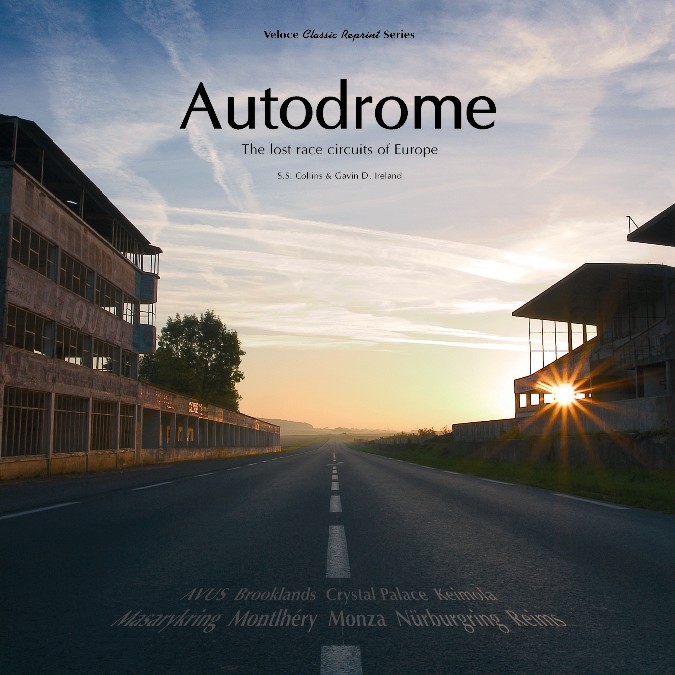
Autodrome: The lost race circuits of Europe, by S.S.Collins and Gavin D.Ireland.
ISBN: 978-1-787111-29-5, £45.00 (+ P&P).
Published by Veloce Publishing Ltd, Veloce House, Parkway Farm Business Park, Middle Farm Way, Poundbury, Dorchester DT1 3AR (UK).
Tel: +(0)1305 260068.
E-mail: info@veloce.co.uk. www.veloce.co.uk.
Click here to order or see a sample
There are more detailed books on some of the individual circuits out there - Bill Boddy's books on Montlhéry and Brooklands for instance (although Boddy omits the ghost stories mentioned here), and Motor Sport covered Brno in a feature some years ago (in a little more detail, as the history on this circuit is strangely much lighter than for the others), but you would need multiple titles to cover the same ground. And the photography....
There are of course period photographs showing the circuits from the time they were used, but what makes the book stand out are Gavin Ireland's contemporary photo's, dripping with atmosphere and ghosts of time past. The use of low level sun and dusk to illuminate structures is cleverly done, and the cover shot from Reims and the sign-off shot from Montlhéry make you go back to look again and see what you missed. The cover shot in particular I'd like to see in an even larger format, to see all of the details bathed in the gentle orange glow of the sun.
There are many more lost circuits out there, but not many where you could really find the structures which help set the photographs apart in this book, so you can see why the number of tracks covered is relatively small - it was never intended to be an encyclopedia of track history. It was an enjoyable read which unearthed stories and facts not covered elsewhere.
Errata
PG4 - Spa-Franchorchamps - should be Spa-Francorchamps
PG37 - "The banked circuit saw occasional use during the 1960s and the Monzanapolis events were repeated." Should read "not repeated".
PG68 - The Nürburgring distances are slightly mixed up. It lists the Nordschleife as 14.2 miles/22.8 km, the Sudschleife as 4.8 miles/7.7 km, and the Gesamtstrecke as 17.5 miles/28.265 km. It then says in the next paragraph that "run over the full course" of 19 miles/28 km. The author has simply added together the Nordschleife and Sudschleife distances in miles, but 19 miles is not 28 km (see the Gesamtstrecke distances) - the circuits shared some track, and when used together came to the shorter 17.5 mile distance.
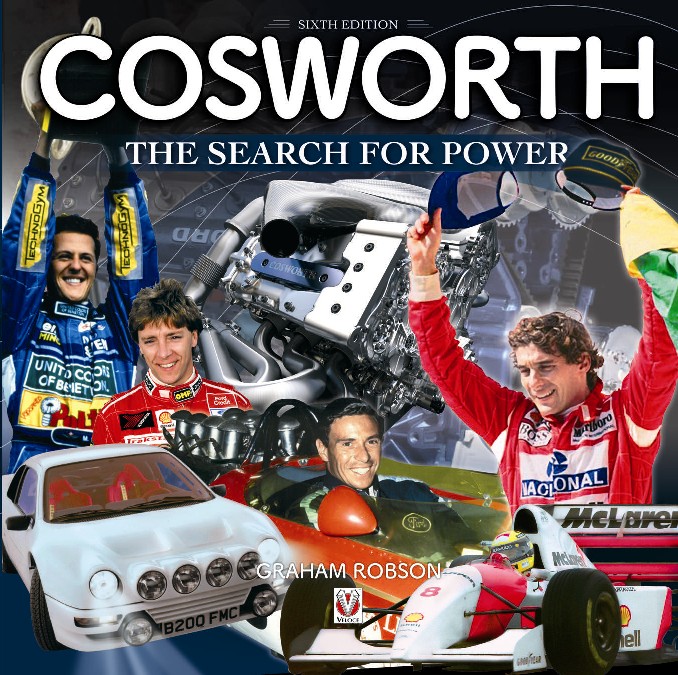
Cosworth: The Search For Power, by Graham Robson.
ISBN: 978-1-845848-95-8, £55.00 (+ P&P).
Published by Veloce Publishing Ltd, Veloce House, Parkway Farm Business Park, Middle Farm Way, Poundbury, Dorchester DT1 3AR (UK).
Tel: +(0)1305 260068.
E-mail: info@veloce.co.uk. www.veloce.co.uk.
Click here to order or see a sample
Cosworth for me growing up meant the Ford RS500 touring car (the Ford RS200 was an odd thing piloted by Martin Schanche, and appeared once a year on BBC Grandstand when they showed the Brands Hatch rallycross grand prix), a massively powerful car that dominated its races. This was rapidly followed by the Sapphire Cosworth, a family car which would give a Ferrari a run for its money. All are covered in this book. It is weighty, published on thick paper, and there is a lot to read. So much so that I almost didn't finish reading it before the deadline I had given for writing this review.
The book covers Cosworth, so is appreciably different to the Duckworth autobiography reviewed earlier. It of course covers some of the same ground, but as it follows the company, the story diverges increasingly as time goes on. I appreciated the fact that the book was not F1 centered - of course it covers it, and well, and as Cosworth gave us the DFV how could it not, but it is only part of the story. There is a good description of CART history, describing much unknown work on engines raced by other concerns, as well as details of engine developments through the years for Ford. There is much that is new here for those who've only had European based news sources to keep up with the sport.
This is the 6th edition of this title, so allows the narrative to be updated and follow more recent topics. It is written in a style which is easy to read, and has lots of information interspersed with timely and illuminating anecdotes. For those with a more corporate interest, turnover figures are also given on a year by year basis. It really does follow the company, rather than just the people.
As the book gets more recent, it is increasingly struck by the curse of corporate secrecy, with fewer and fewer power outputs given, and more and more projects hinted at but not described, just a comment that we may get to know in future. This is reality, but frustrating at the same time. We can only hope that there is a future 7th edition which fills in these gaps, but then there will be new ones created, and so the cycle repeats....
Errata
PG164 - one typo - "listewning". And that's it, the book is well researched!
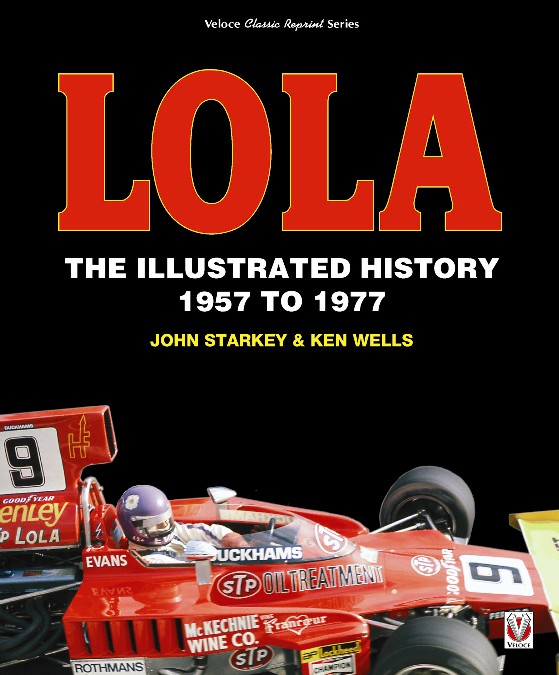
Lola: The Illustrated History 1957 to 1977, by John Starkey and Ken Wells.
ISBN: 978-1-787111-04-2, £37.50 (+ P&P).
Published by Veloce Publishing Ltd, Veloce House, Parkway Farm Business Park, Middle Farm Way, Poundbury, Dorchester DT1 3AR (UK).
Tel: +(0)1305 260068.
E-mail: info@veloce.co.uk. www.veloce.co.uk.
Click here to order or see a sample
Having seen what author John Starkey did in his book Lola T70 - The Racing History & Individual Chassis Record, you could expect more of the same, but this book isn't to the same level of detail, and perhaps my views are slightly coloured by how good that book was. I'm not saying that this isn't a good book - it is - it just isn't a great one - it left me with a number of questions which I expected the book to have answered.
The author has a preference for big formula cars and sportscars when describing things - it goes through all of the different type numbers sequentially. However, on page 89 it gives a total of 122 words to cover the T200/202/204 formula ford cars, of which 120 were built. These were some of the most prolific models the company constructed - there were only 125 examples of other chassis/models constructed in the same period, so this was near enough half of everything built. The details were very light at this point, with no explanation of the differences between the three type variants. I found this disappointing given the level of detail elsewhere. For example, for larger formula cars individual chassis numbers are sometimes quoted, with details of racing through to historic racing. It's just a little inconsistent.
There are some great shots of the different cars, and it is easy to see the evolution of thought over time as you browse through the images. There are many exploded technical drawings of various components, which was great to see, and helps to show how complex and how much work goes into designing things. But why were they only for the T400 F5000 car? They are spread through the last third of the book, and as most pictures and diagrams are located near their respective text entries, you could be forgiven for thinking that they refer to other cars unless you read the footnotes carefully.
Some further questions which arose:-
- Why do only German names have diacritics? The Österreichring and Nürburgring are correctly written, but others such as Angoulême and Lourenço Marques are not.
- On PG96 it mentions the T230 from 1971 being an F1 car which was not built. Why? What was it meant to have been? There is no other mention in the text.
- PG132 - Who was Jag, who span off at Silverstone? There was no mention of the driver before.
And when you finally get to pg 176 the text just stops. Having described the F3 T570, the book goes into a picture section of the cars in historic racing. There is no over-arching review of Lola and what it had achieved, of how the company had developed and what it was doing compared to others. It doesn't put Lola into context. The book is not a history of Lola, but it is a catalogue of the racing cars they built, and a list of who drove the more important ones.
I find myself getting to the end of this and being in two minds - I've given an account of the issues I had with it, but then find myself feeling that this is coming across far too negatively. I liked the book, it has loads of great detail, and rarely in one book do you ever see something covering so many different racing series across both Europe and the US (not forgetting Australasia and South Africa as well, as Lola cars competed in both the Tasman Series and the Springbok Series). I think that in the end what you should do is read this book before the Lola T70 one from the same author. Also consider that this is volume 1, and there is a second volume covering 1978 to 1997. Perhaps there needs to be a volume 3 covering 1997-2012.....
Errata
PG45 - Roger McClusky -> should read Roger McCluskey.
PG75 - Following seems to be a conjunction of two separate sentences: "Jackie Epstein found his experience with a T70 in 1966, when Paul Hawkins was driving his car in the first Can-Am events, meant that with the deletion of Group 7/9 racing he could use a Group 4 coupé based on Epstein had been racing a Ferrari 275LM in long-distance sportscar events....". Think it should be "...based on <something>. Epstein had been....", where "something" is a missing car designation, probably a T70 Spyder.
PG77 - Picture description - Carl Haa's should be Carl Haas'.
PG94 and 96 - Helmuth Marko, should be Helmut.
PG143 - Raupuna should be Ruapuna.
PG149 and 165 - Arlo Lawler should read Alo Lawler.
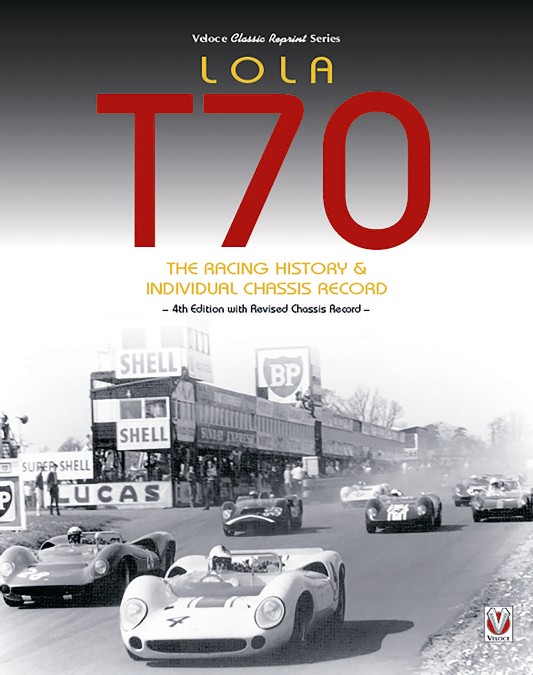
Lola T70 - The Racing History & Individual Chassis Record, by John Starkey.
ISBN: 978-1-787110-51-9, £35 (+ P&P).
Published by Veloce Publishing Ltd, Veloce House, Parkway Farm Business Park, Middle Farm Way, Poundbury, Dorchester DT1 3AR (UK).
Tel: +(0)1305 260068.
E-mail: info@veloce.co.uk. www.veloce.co.uk.
Click here to order or see a sample
The book itself starts by describing the genesis of the T70, starting with the Ford GT40, and how Broadley moved on to create his own car based on his own ideals. It the moves through the five year front line career of the car, documenting the changes through Mark II, III and IIIb, as well as the T160, T162, T163 and T165 cars, which had a direct bearing on how the car developed. Liberally spread through the book are images of the cars at the various circuits around the world where it competed, together with many shots of the internals (anyone for fluid reservoirs, suspension uprights or engine bearers?), and documents showing car delivery specifications. Short of having an actual Haynes manual for the car, you couldn't do better. Included also are comments from contemporary drivers, and copies of track tests done in the past. It fully describes the car.
The author owned more than one T70 himself, and the passion for the car shows through, as every little detail which could be found has been added. The only possible thing to say against the book is that some of the images could be a little crisper, although I wasn't so sure about the chapter on historic racing. But this is definitely just a personal bias - I like to see the cars being driven, so that you can hear how they sounded, and feel more of the impact, but the actual racing doesn't interest me so much, nor does the fettling of the cars on newer rubber so that they go better than they ever did in period. If they weren't raced though people wouldn't maintain them, and the cars wouldn't be seen, so it's something to live with.
The fact that this book is on its fourth edition, having been first published in 1993, gives you a good hint as to the quality of this book. It is recommended.
Errata
PG 61 - Roger McKluskey should read Roger McCluskey.
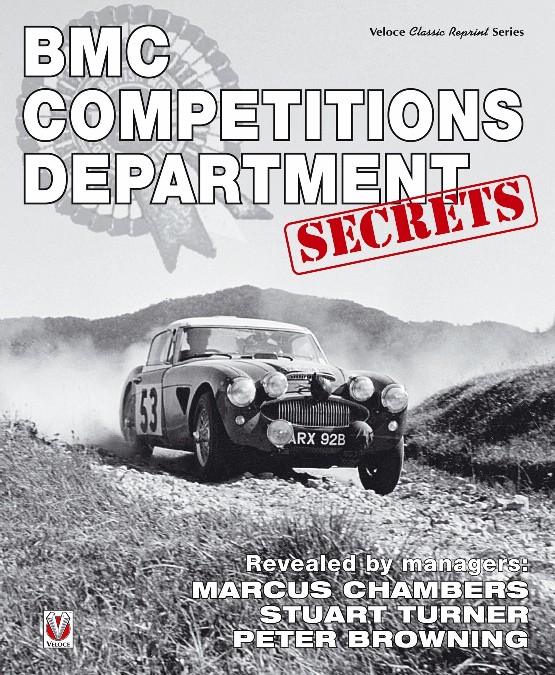
BMC Competitions Department Secrets, by Peter Browning, Marcus Chambers, Stuart Turner and Philip Young.
ISBN: 978-1-849948-94-8, £24.99 (+ P&P).
Published by Veloce Publishing Ltd, Veloce House, Parkway Farm Business Park, Middle Farm Way, Poundbury, Dorchester DT1 3AR (UK).
Tel: +(0)1305 260068.
E-mail: info@veloce.co.uk. www.veloce.co.uk.
Click here to order or see a sample
This isn't a book if you are after narrative - it doesn't do lengthy descriptions of the rallies undertaken, making do with short chapters from each of the three department managers. But what it does do is to publish numerous internal memos and photographs, fleshing out from the companies point of view what was happening. And it is highly illuminating, showing what was concentrated on and thought important, and how things were done. For example, in order to short-cut customs bureaucracy, chassis plates and registration numbers were sometimes switched, so when taken together with cars which were re-shelled, it makes it somewhat difficult to work out whether a car which is claimed to have won a rally actually did so. Pity the poor historian....
Some of the memos though may require a magnifying glass to read, as a closely typed A4 page when reduced to letter size can be hard to read, and the reproduction for some isn't great, although that may also have something to do with the quality of the original paperwork being shown. Nevertheless, it is an informative an interesting view of what went on behind the scenes. One memo for the London to Sydney Marathon was particularly amusing in its content and innocence: "Suggest that it would be a wise precaution for each car to carry a small fire arm for some personal protection in the event of a breakdown or accident in remote parts. As most members of the team have already demonstrated their prowess at this art in the past, I am leaving each crew to make their own arrangements for the supply of suitable armoury." Apparantly weapons weren't taken in the end, but I have images of co-drivers with a long list of things to tick off before leaving: Map, check. Stop watch, check. Walther PPK, check..... You wouldn't see that in the WRC today.
Maybe the directives on firearms should have been taken on by the department managers, as it may have helped with the politics of the department closure, which is also described through various memos. These memos help to show the human effect of such decisions, bringing through the hurt and upset at having to disband and implement others decisions. It is worth the read, and a different take on how to describe the rallying world and teams.
Errata
PG 32 - 1955 Tulip Rally - #137 MG Magnette is captioned as being Geoff Holt. Holt drove #148, #137 was driven by Shaw/Lawton.
PG 41 - 1957 Liege-Rome-Liege Rally - Caption for top picture says that Pat Moss finished fourth - she was not fourth overall, she finished 23rd. Fourth in class perhaps?
PG 42 - 1958 Monte Carlo Rally - says that #317 was Brookes brothers. They drove #304 - #317 was Bremner/Oldworth.
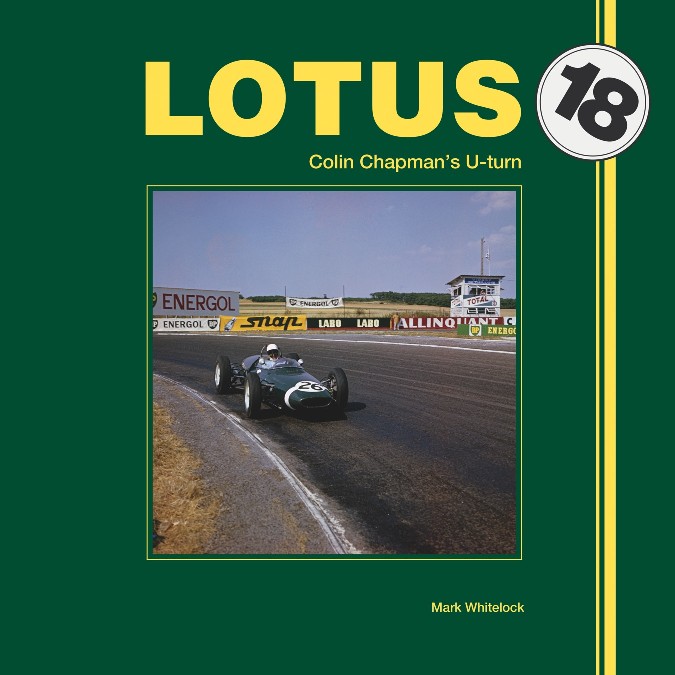
Lotus 18 - Colin Chapman's U-turn, by Mark Whitelock.
ISBN: 978-1-845845-20-9, £50 (+ P&P).
Published by Veloce Publishing Ltd, Veloce House, Parkway Farm Business Park, Middle Farm Way, Poundbury, Dorchester DT1 3AR (UK).
Tel: +(0)1305 260068.
E-mail: info@veloce.co.uk. www.veloce.co.uk.
Click here to order or see a sample
So there is a lot to cover, which this book does in detail, mixing detailed photographs of suspension and car internals, with diagrams of chassis layouts and pictures from various races, sprinkled with short side pieces on the drivers who competed in them, the major circuits it competed on, and the teams which campaigned it. The book goes chronologically through each year in which the car competed, whether in F1 or the South African Gold Star series, before summarising each chassis history as far as they are known (and this is more difficult than may be imagined, with chassis plates being swapped to help avoid customs duties - read more in the book....). Quotes from the people involved are also used to help add more context to the prose.
There are many great images, and I think that the image on page 40 of Stirling Moss in a Cooper with wheels pointing at all angles while followed by Innes Ireland in an 18 with wheels perfectly upright, summarises exactly why it was such a good car. It wasn't really the u-turn suggested by the book title - when you are being beaten by a car with the same engine repeatedly then you take a look at why - the real development was the suspension and approach to frontal area. This can be seen clearly from the numerous diagrams and images throughout the book.
The book seems to assume a certain age of its readers, as things such as temperatures and measures are often given only in imperial, and I was taught entirely in metric. Also, some things are seen through a too much Lotus 18 centric prism. For instance, Goodwood for me isn't remembered for Innes Ireland's two wins there, significant though they were for the 18 (and as stated in the text) - instead it is remembered as the site of Bruce McLaren's fatal accident, and the career ending one for Stirling Moss. That last one was in a Lotus 18/21, another variant covered within the book.
In summary, the book is a well crafted history of a significant car in the development of Grand Prix racing. It is nicely laid out, and unusually for my last set of reviews, doesn't come with any errata. It's a good book....
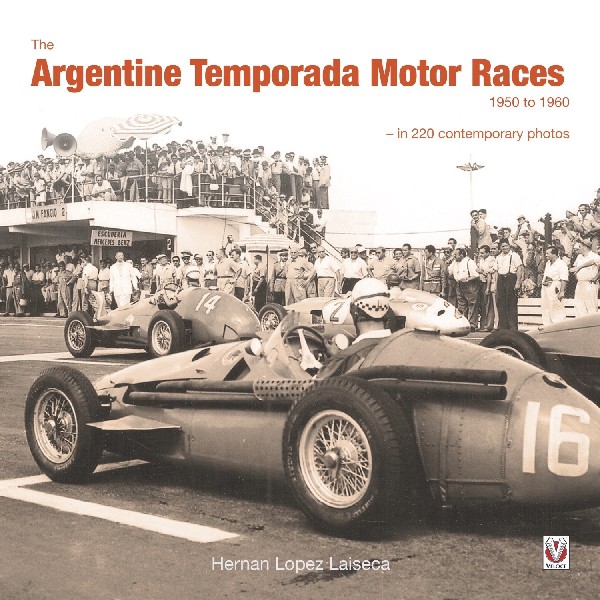
The Argentine Temporada Motor Races 1950 to 1960, by Hernan Lopez Laiseca.
ISBN: 978-1-845848-28-6, £35 (+ P&P).
Published by Veloce Publishing Ltd, Veloce House, Parkway Farm Business Park, Middle Farm Way, Poundbury, Dorchester DT1 3AR (UK).
Tel: +(0)1305 260068.
E-mail: info@veloce.co.uk. www.veloce.co.uk.
Click here to order or see a sample
The tag line of the book gives a good description of how the book is laid out - "in 220 contemporary photos". The book is heavily photograph based, with many atmospheric photographs showing the drivers, the cars, and the events. However, the accompanying text although informative is a little terse, and as a result sometimes leaves a few questions hanging (as well as sometimes repeating the photograph captions). For example, on page 26 it says that after the 1950 Mar del Plata race, that "the relationship between the Italian and Argentinian press deteriorated and an incredible media battle ensued", but then says nothing more about it. Bearing in mind that this was before the era of instant communications, it would have been interesting to know how this developed and over how long, and whether it had any further long term effects. The terseness also extends to the concluding lines - having described the final race, there is one line saying that the golden age of Argentine motoring was over, with no enlightenment as to why or for what reasons the races were no longer held. A couple more lines are ideally needed.
Additionally, the book doesn't appear to cover all of the races which occurred in Argentina during this period, even if we take into account only single-seater events. Missing from 1950 is the Gran Premio de Paraná held on the 12th November 1950 at Parque Urquiza, Paraná. Missing also are any races from 1952, with the VI Gran Premio del General Juan Perón y de la Ciudad de Buenos Aires being held on the 9th March 1952 in Buenos Aires, and the VI Gran Premio Extraordinario de Eva Duarte Perón being held on the 16th March 1952 at the same venue. No indication is given as to why there was nothing reported for 1952, and it seems a strange omission. Also missing are the winning times for the single seater races, although they are given for the sportscar events. Otherwise full race results are given for all of the races reported.
In conclusion, it wasn't quite the book I hoped it would be. It has wonderful photographs, but the textual content is slightly flawed. However, it covers a series of races not generally covered elsewhere, so for that and the photo's it is still worth purchasing.
Errata
PG 125 - Gran Premio de la Republica Argentina. Missing #24 Adolfo Schwelm Cruz, who drove a Cooper-Bristol T20, DNF/20 laps/wheel off.
PG 125 - GP de BA - winner was Giuseppe Farina rather than José (a number of drivers have their names transcribed into the Spanish equivalent in other places too).
PG 130 - GP de BA - Was a two part race, and the race result given is the heat 1 result, not the aggregate overall result. Heat 2 and aggregate results are missing.

Grand Prix Ford - Ford, Cosworth and the DFV, by Graham Robson.
ISBN: 978-1-845846-24-4, £65.00 (+ P&P).
Published by Veloce Publishing Ltd, Veloce House, Parkway Farm Business Park, Middle Farm Way, Poundbury, Dorchester DT1 3AR (UK).
Tel: +(0)1305 260068.
E-mail: info@veloce.co.uk. www.veloce.co.uk.
Click here to order or see a sample
This book is well laid out and put together on high quality and weighty paper, and has a section for every single type of car which has ever raced in F1 with a DFV or derivative engine. There are many images, as well as a list of some of the other projects the engine was used for. It also includes brief biographies of key people in the engines' life story, such as Alan Mann, Harley Copp and Mike Kranefuss. It is encyclopaedic, but I couldn't help but notice that the author couldn't decide whether to use country codes or the full country names when giving the constructors, it randomly switching between them even for the same country. But that is the smallest of niggles, and is only noticable because of the high standard of the rest of the book. The book was originally started by Anthony Pritchard, but following his death was taken over and completed by Graham Robson, who expanded on the wording and the layout.
The book is about Ford, so would have been interesting to read more about how the success was viewed from the US headquarters, given that the drive for Total Performance came from there, and it had to be approved at board level. What drove their approval? How come they did it so quickly? Why did they continue funding the program for so long given that their image targets had been achieved, and that the marques they were competing against in the marketplace weren't competing in the same race series? If the subject is Ford, I would have liked to have seen more about the whole, rather than just the Ford Europe point of view.
The previously reviewed autobiography of Keith Duckworth makes an excellent companion volume to this book - read both, and you will have a good understanding of what happened and the people behind it. But this is the definitive guide to the DFV and derivative engined F1 cars, by an author who has met and spoken to most of the main actors over the years. It's a book I'd happily leave out on the coffee table for others to browse through, read bits and go "I remember that", or "Do you remember
PG 128, Col 1 - "March 86B F3000 car, which had just won the 1976 Championship". Should be 1986 Championship.
PG 147, Col 2 - "Way of optimising the 'ground effects' which Cosworth DFF runners...". Should be Cosworth DFV runners.
PG 154, Col 1 - "Onyx's co-founders, Mike Earls and....". Should read Mike Earle.
PG 195, Col 2 - "Nomally-aspirated teams would compete for..." Should read "Normally-aspirated".
PG 197 onwards - Williams type numbers frequently written FWO (with letter O) rather than FW0 (number 0).
Errata

Dino - The V6 Ferrari, by Brian Long.
ISBN: 978-1-904788-39-3, £40.00 (+ P&P).
Published by Veloce Publishing Ltd, Veloce House, Parkway Farm Business Park, Middle Farm Way, Poundbury, Dorchester DT1 3AR (UK).
Tel: +(0)1305 260068.
E-mail: info@veloce.co.uk. www.veloce.co.uk.
Click here to order or see a sample
The book has an elegant cover, quality paper and many sharp images, taking you briefly through the story of Ferrari before concentrating on anything which had a V6 engine, detailing the show cars presented at the motor shows as well as actual production vehicles, even quoting the detail differences between different mark runs of the same vehicle type. It runs through to the final V8 models, which given the title I guess is the exception which proves the rule! It also includes facsimiles of the product brochures from both Fiat and Ferrari, the book covering the Fiat Dino models as well.
Additionally included is a brief buyers' guide, running through the things to look out for when buying one, including a picture of a very sad looking example needing a lot of body work attention, but still costing in excess of £130,000 at 2015 auction prices - these cars aren't cheap. They also need more regular mechanical attention than a modern car, as you may expect, and services can take three days, so don't expect to buy one and have running costs like your every day car.
As a bonus, the book has even taught me new vocabulary - jounce - the compression part of a shock absorber cycle before you get the rebound. But perhaps that says more about me!
So, in short, the book is a detailed record of the Dino cars and the changes the underwent through its seven year run. If you own one or are looking into the history of them, then this is for you.
Errata(ish)
PG 10, column 1 "Ninth in the 1919 Targa [Florio]" - Ferrari did not finish, only completing 3 laps out of 4. Depends on whether you include DNFs as places, which wasn't usually done in period. Admittedly the reproduced CMN advert from that year says Ferrari was 3rd in class, so....
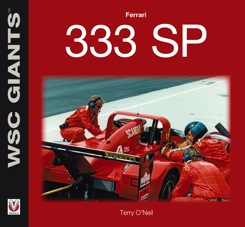
WSC Giants: Ferrari 333 SP, by Terry O'Neil.
ISBN: 978-1-845847-58-6, £16.99 (+ P&P).
Published by Veloce Publishing Ltd, Veloce House, Parkway Farm Business Park, Middle Farm Way, Poundbury, Dorchester DT1 3AR (UK).
Tel: +(0)1305 260068.
E-mail: info@veloce.co.uk. www.veloce.co.uk.
Click here to order or see a sample
This book is a chronicle of the cars competition career, listing every race which was entered, together with the drivers, the results, and which chassis finished where, so it is a detailed log with small race descriptions. As the cars career was mainly focussed on the US racing scene, that is where the book concentrates, and it chronicles how US scene went from IMSA, through the USRRC, Professional Sports Car Racing to the ALMS, a period of of great turbulence in sportscar racing.
It is a good book (there are a couple of minor errors - on page 35, which covers the 1996 Sebring 12 Hrs, it says that a Porsche came down off the banking and collided with Baldi - Sebring is an airfield circuit and there is no banking) - it would have been a great book if the author could have interviewed the designers and asked them why they did some of the things they did, what made them accept this proposal and not others. And the drivers - how did they feel in the car, how did it compare to others in how it drove and handled? How was the car developed over time, and why? And a summary/overview of the career at the end would close the story better. But there is nothing else out there which chronicles the cars history, and it does it in detail. I liked it.
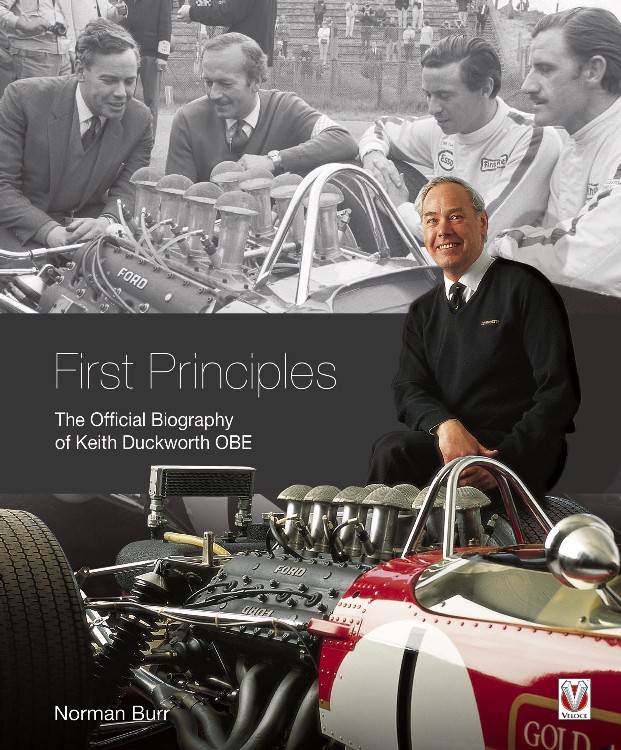
First Principles - The Official Biography of Keith Duckworth OBE, by Norman Burr.
ISBN: 978-1-845845-27-5, £35.00 (+ P&P).
Published by Veloce Publishing Ltd, Veloce House, Parkway Farm Business Park, Middle Farm Way, Poundbury, Dorchester DT1 3AR (UK).
Tel: +(0)1305 260068.
E-mail: info@veloce.co.uk. www.veloce.co.uk.
Click here to order or see a sample
And this is where this book comes in. The official biography of Keith Duckworth, it charts Keith's story from his family beginnings in Blackburn, through his school, University studies, the founding of the company and on through his various projects. The author has interviewed many of his fellow co-workers, and quotes them extensively through the text, together with many quotes from his family. And together they help to flesh out a feeling of who the man was, and how he operated. The author blends them into the narrative to help give a feel for why things were done as they were. Added to this are numerous personal photographs of the people involved, and the projects undertaken, which help to add colour to the text. The picture on the front cover of a young Keith Duckworth overlooking his engine design while talking to Colin Chapman really shows what he was about, and helps to convey more than text alone ever could.
In addition, the book doesn't exclusively focus on motorsport, as Cosworth was involved in many more projects than just F1, and it is all the better for that. But the reader should be aware when reading this book that this isn't just a biography of Duckworth, it also covers all of the projects that Cosworth was involved with during his time there, some of them of which Duckworth might only have been involved with in passing. But it is a good read. The only thing I would request is that when the book is reprinted, please can the footnotes be moved from the end of the chapters to the bottom of the page where they are used - this reviewer ended up having to bookmark the end of the chapter so that they could be read in context!
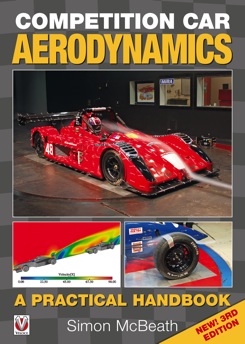
Competition car aerodynamics (3rd edition), by Simon McBeath.
ISBN: 978-1-845841-23-1, £40.00 (+ P&P).
Published by Veloce Publishing Ltd, Veloce House, Parkway Farm Business Park, Middle Farm Way, Poundbury, Dorchester DT1 3AR (UK).
Tel: +(0)1305 260068.
E-mail: info@veloce.co.uk. www.veloce.co.uk.
Click here to order or see a sample
The book isn’t afraid to use maths to explain things (although this reviewer thinks that one of the worked examples is incorrect – see the addendum to this review), but this shouldn’t put a prospective reader off. The maths help to explain what the CFD examples are showing and why, and what the CFD algorithms are doing. And that is the point of this book – an explanation of how things work and how to apply them to your race car, whether it is a saloon car or single seater. It doesn’t aim to give you exact figures and tell you where to place your new wing, but instead an idea of where to look and how to go about deducing what would work best, together with methodologies for testing your newly discovered setup.
So yes, the book is authorative, and well worth a read for those who want to understand the why when looking at the latest aerodynamic designs in motorsport. It works whether you are in interested viewer, or whether you are looking at pointers for building your own car. And although I don’t have a car of my own, I’d love to sit in on a session at MIRA when the author was testing one of the cars featured in the book!
Addendum
The equation on page 133 for balancing front and rear wings based on weight distribution reads:

Which is missing brackets to begin with, confusing the equation. It should read:

The example says that the 1/2ρ and V2 cancel each other out as they are on both sides of the equation, but mathematically that’s not true as these values are not in both terms on both side of the equation. So, let’s get rid of some of the fractions, to make the next steps easier. Firstly, the 38/62:

Let’s get rid of the fractions, so multiply all by 124:

Rearranging to get the same terms on each side:

And taking out the common factors:

Rearranging to give:

Taking ρ (air density) to be 1.225 kgm-3, Afront to be 0.4 m2, Arear to be 0.5885 m2, and assuming a velocity of 60 ms-1 (the 217 kph maximum speed of the car), together with a CLrear of 2.95, we get a CLfront value of 1.81, which is substantially smaller than the 2.67 value calculated.
Actually, because the V2 component is so big, the first term is tiny, and hence if you ignored the first part, you end up with an equation in which the front coefficient is simply the rear multiplied by the weight distribution fraction.
Update
Following clarification with the author, who was kind enough to discuss this in detail, what we have in the equation on page 133 is a confusion between a subtraction and a negative number. So -CL means negative CL, in which case the two terms do cancel out as suggested, and the quoted values are correct. Thank you for taking the time to point this out!